
List of mammals of Canada
Encyclopedia
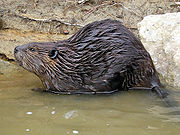
Canada
Canada is a North American country consisting of ten provinces and three territories. Located in the northern part of the continent, it extends from the Atlantic Ocean in the east to the Pacific Ocean in the west, and northward into the Arctic Ocean...
. Its large territorial size and variety of ecosystems, ranging from mountains to plains to urban housing, mean that Canada can harbour a great variety of species, including nearly half of the known cetaceans. The most well-represented order is that of the rodent
Rodent
Rodentia is an order of mammals also known as rodents, characterised by two continuously growing incisors in the upper and lower jaws which must be kept short by gnawing....
s, and the smallest that of the Didelphimorphia
Didelphimorphia
Opossums make up the largest order of marsupials in the Western Hemisphere, including 103 or more species in 19 genera. They are also commonly called possums, though that term technically refers to Australian fauna of the suborder Phalangeriformes. The Virginia opossum was the first animal to be...
(common opossums).
Studies of mammals in Canada hearken back to the 1795 northern explorations of Samuel Hearne
Samuel Hearne
Samuel Hearne was a an English explorer, fur-trader, author, and naturalist. He was the first European to make an overland excursion across northern Canada to the Arctic Ocean, actually Coronation Gulf, via the Coppermine River...
, whose account is considered surprisingly accurate. The first seminal work on Canadian mammals, however, was John Richardson
John Richardson (naturalist)
Sir John Richardson was a Scottish naval surgeon, naturalist and arctic explorer.Richardson was born at Dumfries. He studied medicine at Edinburgh University, and became a surgeon in the navy in 1807. He traveled with John Franklin in search of the Northwest Passage on the Coppermine Expedition of...
's 1829 Fauna Boreali-Americana. Joseph Burr Tyrrell was the first to attempt to produce, in 1888, a comprehensive list of Canadian mammalian species. Ernest Thompson Seton
Ernest Thompson Seton
Ernest Thompson Seton was a Scots-Canadian who became a noted author, wildlife artist, founder of the Woodcraft Indians, and one of the founding pioneers of the Boy Scouts of America . Seton also influenced Lord Baden-Powell, the founder of Scouting...
and Charles-Eusèbe Dionne
Charles-Eusèbe Dionne
Charles-Eusèbe Dionne , also known as Charles Eusebe or C. E. Dionne, was a French Canadian naturalist and taxidermist. He is considered the first professional French Canadian ornithologist...
's work were also important. Modern Canadian publications with interest in mammalogy
Mammalogy
In zoology, mammalogy is the study of mammals – a class of vertebrates with characteristics such as homeothermic metabolism, fur, four-chambered hearts, and complex nervous systems...
include The Canadian Field Naturalist, the Canadian Journal of Zoology and the French-language Le Naturaliste Canadien
Le Naturaliste Canadien
Le Naturaliste Canadien is a Canadian French-language peer-reviewed scientific journal published semiannually by the Société Léon-Provancher d'Histoire Naturelle du Canada. The journal publishes articles on all topics of natural sciences with a specific focus on ecology and conservation biology in...
.
Several species of mammal have particular symbolism. The Canadian Horse
Canadian Horse
The Canadian Horse is a breed of horse developed in Canada. Although previously relatively unknown due to its rarity, the Canadian Horse has influenced many other North American breeds, including the Morgan, American Saddlebred, and Standardbred...
and Beaver
Beaver
The beaver is a primarily nocturnal, large, semi-aquatic rodent. Castor includes two extant species, North American Beaver and Eurasian Beaver . Beavers are known for building dams, canals, and lodges . They are the second-largest rodent in the world...
are official symbols of Canada, and several provinces have designated native species as symbols.
Order Rodentia: Rodents
RodentRodent
Rodentia is an order of mammals also known as rodents, characterised by two continuously growing incisors in the upper and lower jaws which must be kept short by gnawing....
s make up the largest order of mammals, with over 40 percent of mammalian species. They have two incisor
Incisor
Incisors are the first kind of tooth in heterodont mammals. They are located in the premaxilla above and mandible below.-Function:...
s in the upper and lower jaw which grow continually and must be kept short by gnawing. Most rodents are small though the capybara
Capybara
The capybara , also known as capivara in Portuguese, and capibara, chigüire in Venezuela, Colombia, and Ecuador ronsoco in Peru, chigüiro, and carpincho in Spanish, is the largest living rodent in the world. Its closest relatives are agouti, chinchillas, coyphillas, and guinea pigs...
, a rodent native to South America, can weigh up to 45 kg (100 lb).
| Common name (French French language French is a Romance language spoken as a first language in France, the Romandy region in Switzerland, Wallonia and Brussels in Belgium, Monaco, the regions of Quebec and Acadia in Canada, and by various communities elsewhere. Second-language speakers of French are distributed throughout many parts... name) |
Species (Authority) |
Preferred habitat | Native range | Status |
|---|---|---|---|---|
| Family Erethizontidae: New World porcupines | ||||
| North American Porcupine North American Porcupine The North American Porcupine , also known as Canadian Porcupine or Common Porcupine, is a large rodent in the New World porcupine family. The Beaver is the only rodent larger than the North American Porcupine found in North America...  (Porc-épic d'Amérique) |
Erethizon dorsatum (Linnaeus, 1758) |
Forests | South of the tree line |
|
| Family Aplodontiidae: The Mountain Beaver | ||||
| Mountain Beaver Mountain Beaver The Mountain Beaver is the most primitive extant rodent. Not to be confused with the North American beaver Castor canadensis, or its relative the Eurasian beaver, Castor fiber, it has several common names including Aplodontia, Boomer, Ground Bear, and Giant Mole...  (Castor de montagne) |
Aplodontia rufa (Rafinesque, 1817) |
Montane forests | Southern British Columbia |
|
| Family Castoridae Castoridae The family Castoridae contains the two living species of beaver and their fossil relatives. This was once a highly diverse group of rodents, but is now restricted to a single genus, Castor.- Characteristics :... : Beavers |
||||
| North American Beaver
(Castor) |
Castor canadensis (Kuhl Heinrich Kuhl Heinrich Kuhl was a German naturalist and zoologist.Kuhl was born in Hanau. He became assistant to Coenraad Jacob Temminck at the Leiden museum. In 1817 he published a monograph on bats and in 1819 he published Conspectus psittacorum... , 1820) |
Humid areas of forests. | All of Canada below the tree line except drier parts of the Prairies |
|
| Family Sciuridae: Squirrels | ||||
| Eastern Gray Squirrel Eastern Gray Squirrel The eastern gray squirrel is a tree squirrel in the genus Sciurus native to the eastern and midwestern United States, and to the southerly portions of the eastern provinces of Canada... 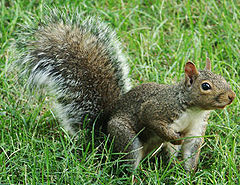 (Écureuil gris) |
Sciurus carolinensis (Gmelin Johann Friedrich Gmelin Johann Friedrich Gmelin was a German naturalist, botanist, entomologist, herpetologist and malacologist.- Education :Johann Friedrich Gmelin was born as the eldest son of Philipp Friedrich Gmelin in 1748 in Tübingen... , 1788) |
Prefers deep forests, but frequent in urban areas. | Southern Manitoba and northwestern Ontario, southern Quebec, Ontario and New Brunswick. |
|
Eastern Fox Squirrel
.jpg) (Écureuil fauve) |
Sciurus niger (Linnaeus, 1758) |
Edge of forests and groves | Southern Manitoba and Saskatchewan, British Columbia and Pelee Island |
|
| Douglas Squirrel Douglas Squirrel The Douglas Squirrel is a pine squirrel found in the Pacific coastal states and provinces of North America. It is sometimes known as the Chickaree or Pine Squirrel, but since Chickaree is also used for the American Red Squirrel and Pine Squirrel for the genus Tamiasciurus, these alternative names... 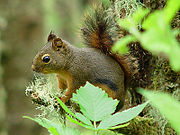 (Écureuil de Douglas) |
Tamiasciurus douglasii (Bachman John Bachman The Rev. John Bachman was an American Lutheran minister, social activist and naturalist who collaborated with J.J. Audubon to produce Viviparous Quadrapeds of North America and whose writings, particularly Unity of the Human Race, were influential in the development of the theory of evolution. He... , 1839) |
Coniferous forests | Southwestern British Columbia |
|
| American Red Squirrel American Red Squirrel The American Red Squirrel is one of three species of tree squirrel currently classified in the genus Tamiasciurus and known as pine squirrels... 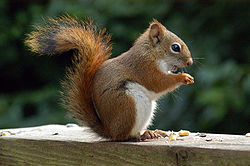 (Écureuil roux) |
Tamiasciurus hudsonicus (Erxleben Johann Christian Polycarp Erxleben Johann Christian Polycarp Erxleben was a German naturalist from Quedlinburg.Erxleben was Professor of physics and veterinary medicine at the University of Göttingen. He wrote Anfangsgründe der Naturlehre and Systema regni animalis... , 1839) |
Forests | Mainland Canada south of the Tree line, except the southern prairies and souwestern British Columbia; Prince Edward, Vancouver and Cape Breton Islands. |
|
| Northern flying squirrel Northern Flying Squirrel The Northern flying squirrel is one of two species of the genus Glaucomys, the only flying squirrels found in North America . Unlike most members of their family, flying squirrels are strictly nocturnal... 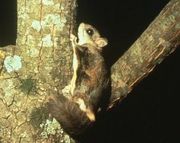 (Grand polatouche) |
Glaucomys sabrinus (Shaw George Shaw George Shaw was an English botanist and zoologist.Shaw was born at Bierton, Buckinghamshire and was educated at Magdalen Hall, Oxford, receiving his M.A. in 1772. He took up the profession of medical practitioner. In 1786 he became the assistant lecturer in botany at Oxford University... , 1801) |
Boreal forest | Mainland Canada south of the tree line except the southern Prairies, Prince Edward and Cape Breton Islands |
|
| Southern flying squirrel Southern Flying Squirrel The Southern Flying Squirrel is one of two species of the genus Glaucomys, the only flying squirrels found in North America . It is found in deciduous and mixed woods in the eastern half of North America, from southeastern Canada, to Florida, USA... 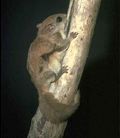 (Petit polatouche) |
Glaucomys volans (Linnaeus, 1758) |
Deciduous forests | Southern Ontario, part of Quebec, southern Nova Scotia |
|
| Black-tailed Prairie Dog Black-tailed Prairie Dog The black-tailed prairie dog , is a rodent of the family Sciuridae found in the Great Plains of North America from about the USA-Canada border to the USA-Mexico border. Unlike some other prairie dogs, these animals do not truly hibernate. The black-tailed prairie dog can be seen aboveground in... 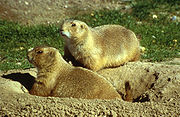 (Chien de prairie à queue noire) |
Cynomys ludovicianus (Ord George Ord George Ord was an American ornithologist.Ord was born in Philadelphia, Pennsylvania. His father was a rope maker and Ord joined him in the business, continuing after his father's death in 1806... , 1815) |
Dry prairies | Small part of southern Saskatchewan |
|
| Hoary Marmot Hoary Marmot The hoary marmot is a species of marmot that inhabits the mountains of northwest North America. Hoary marmots live near the tree line on slopes with grasses and forbs to eat and rocky areas for cover....  (Marmotte des Rocheuses) |
Marmota caligata (Eschscholtz Johann Friedrich von Eschscholtz Johann Friedrich Eschscholtz was a Livonian physician, botanist, zoologist and entomologist.Eschscholtz was born in Dorpat , Governorate of Livonia in the Russian Empire... , 1829) |
Alpine tundra | Rockies, Columbia, and Coast Mountains |
|
| Yellow-bellied Marmot Yellow-bellied Marmot The yellow-bellied marmot , also known as the rock chuck, is a ground squirrel in the marmot genus.-Description:... 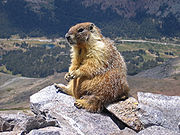 (Marmotte à ventre jaune) |
Marmota flaviventrisa (Audubon John James Audubon John James Audubon was a French-American ornithologist, naturalist, and painter. He was notable for his expansive studies to document all types of American birds and for his detailed illustrations that depicted the birds in their natural habitats... and Bachman, 1841) |
Mountains | Central British Columbia and southernmost Alberta |
|
| Groundhog Groundhog The groundhog , also known as a woodchuck, whistle-pig, or in some areas as a land-beaver, is a rodent of the family Sciuridae, belonging to the group of large ground squirrels known as marmots. Other marmots, such as the yellow-bellied and hoary marmots, live in rocky and mountainous areas, but... (Marmotte commune, Siffleux) |
Marmota monax (Linnaeus, 1758) |
Broken ground | Much of mainland Canada west of the Rockies, inland valleys and part western Yukon |
|
| Vancouver Island Marmot Vancouver Island Marmot The Vancouver Island marmot naturally occurs only in the high mountains of Vancouver Island, in British Columbia, Canada. This particular marmot species is large compared to some other marmots, and most other rodents... (Marmotte de Vancouver) |
Marmota vancouverensis (Swarth, 1911) |
Near the mountain tree line | Vancouver Island |
|
| Columbian Ground Squirrel Columbian Ground Squirrel The Columbian ground squirrel is a species of rodent in the Sciuridae family. It is found in Canada and the United States.... (Spermophile du Columbia) |
Spermophilus columbianus (Ord, 1815) |
Montane open areas | Southern Rocky mountains |
|
| Franklin's ground squirrel Franklin's ground squirrel Franklin's ground squirrel is a species native to tallgrass American prairie, from Canada to the northcentral United States.The species hibernates from early fall to spring, and bears a litter of 6–8 pups at a time... 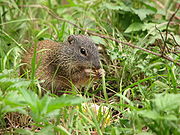 (Écureuil terrestre de Franklin) |
Spermophilus franklinii (Ord, 1815) |
Parklands | Northwestern Ontario and southern Prairies except short-grass prairies |
|
| Golden-mantled Ground Squirrel Golden-mantled Ground Squirrel The golden-mantled ground squirrel, Callospermophilus lateralis, is a type of ground squirrel found in mountainous areas of western North America. It eats seeds, nuts, berries, insects, and underground fungi. It is preyed upon by hawks, jays, weasels, foxes, bobcats, and coyotes. A typical adult... (Spermophile à mante dorée) |
Spermophilus lateralis (Say Thomas Say Thomas Say was an American naturalist, entomologist, malacologist, herpetologist and carcinologist. A taxonomist, he is often considered to be the father of descriptive entomology in the United States. He described more than 1,000 new species of beetles and over 400 species of insects of other... , 1823) |
Montane coniferous forests | Southeastern Rockies |
|
| Arctic Ground Squirrel Arctic Ground Squirrel The Arctic ground squirrel is a species of ground squirrel native to the Arctic.-Subspecies:Listed alphabetically.*S. p. ablusus Osgood, 1903...  (Spermophile arctique) |
Spermophilus parryii (Richardson John Richardson (naturalist) Sir John Richardson was a Scottish naval surgeon, naturalist and arctic explorer.Richardson was born at Dumfries. He studied medicine at Edinburgh University, and became a surgeon in the navy in 1807. He traveled with John Franklin in search of the Northwest Passage on the Coppermine Expedition of... , 1825) |
Tundra without permafrost | Mainland Arctic |
|
| Richardson's Ground Squirrel Richardson's Ground Squirrel Richardson's ground squirrel , or the flickertail, is a North American ground squirrel in the genus Urocitellus... 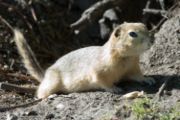 (Spermophile de Richardson) |
Spermophilus richardsonii (Sabine, 1822) |
Prairies | South of the Prairie provinces |
|
| Cascade Golden-mantled Ground Squirrel Cascade Golden-mantled Ground Squirrel The Cascade golden-mantled ground squirrel is a species of rodent in the Sciuridae family. It is found in the Cascade Mountains in the province of British Columbia, Canada and the state of Washington, United States.... 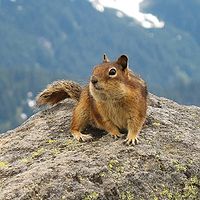 |
Spermophilus saturatus (Rhoads, 1895) |
Southern British Columbia Cascade Range | British Columbia |
|
| Thirteen-lined Ground Squirrel Thirteen-lined ground squirrel The thirteen-lined ground squirrel , also known as the striped gopher, leopard ground squirrel, squinney, and as the leopard-spermophile in Audubon’s day, is a ground squirrel.... (Spermophile rayé) |
Spermophilus tridecemlineatus (Mitchill Samuel Latham Mitchill Samuel Latham Mitchill was an American physician, naturalist, and politician from New York. He was born in Hempstead, New York... , 1821) |
Groves, swamps, uncultivated land | Southern Prairie Provinces |
|
| Yellow-pine Chipmunk Yellow-pine Chipmunk The yellow-pine chipmunk is a species of rodent in the Sciuridae family. It is found in Canada and the United States.... (Tamia amène) |
Tamias amoenus (Allen, 1821) |
Dry montane forests | Southern and central British Columbia and Alberta |
|
| Least Chipmunk Least Chipmunk The least chipmunk is the smallest chipmunk in North America. It is also the most widespread species of chipmunk in North America occurring across north-central and western United States and from British Columbia and southern Yukon to western Quebec in Canada... 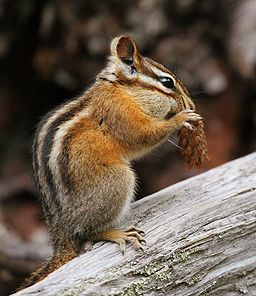 (Tamia mineur) |
Tamias minimus (Bachman, 1839) |
Edges of forests, groves, but also open spaces | Western Quebec to Yukon |
|
| Red-tailed Chipmunk Red-tailed Chipmunk The red-tailed chipmunk is a species of rodent in the Sciuridae family. It is found in Alberta and British Columbia in Canada and Montana, Idaho and Washington in the United States.... (Tamia à queue rousse) |
Tamias ruficaudus (A. H. Howell, 1839) |
High altitude forests and valley pine groves. | Southern British Columbia and Alberta |
|
| Eastern Chipmunk Eastern Chipmunk The eastern chipmunk is a small squirrel-like rodent found in eastern North America, the sole living member of the chipmunk genus and subgenus Tamias....  (Tamia rayé, Petit suisse) |
Tamias striatus (Linnaeus, 1758) |
Deciduous forests | Southern half of Ontario and Quebec, and southern Manitoba |
|
| Townsend's Chipmunk Townsend's Chipmunk Townsend's chipmunk is a species of rodent in the squirrel family Sciuridae. It lives in the forests of the Pacific Northwest of North America, from British Columbia through western Washington and Oregon. A large chipmunk, adults can be from nose to tail... (Tamia de Townsend) |
Tamias townsendii (Bachman, 1839) |
Western Coast lowland and montane Tsuga forests | Southwestern British Columbia |
|
| Family Geomyidae: Pocket gophers | ||||
| Plains Pocket Gopher Plains Pocket Gopher The plains pocket gopher is one of thirty-five species of pocket gopher, so named in reference to their externally located, fur-lined cheek pouches. They are burrowing animals, found in grasslands and agricultural land across the Great Plains of North America, from Manitoba to Texas...  (Gaufre brun) |
Geomys bursarius (Shaw, 1800) |
Fields and banks | Southern Manitoba |
|
| Northern Pocket Gopher Northern Pocket Gopher The Northern Pocket Gopher, Thomomys talpoides, was first discovered by Lewis and Clark on April 9, 1805 at the mouth of the Knife River, North Dakota. These animals are often rich brown or yellowish brown, but also grayish or closely approaching local soil color and have white markings under chin...  (Gaufre gris) |
Thomomys talpoides (Richardson, 1828) |
Open areas | Southern Prairie Provinces and British Columbia |
|
| Family Heteromyidae Heteromyidae The family of rodents that include kangaroo rats, kangaroo mice and rock pocket mice is the Heteromyidae family. Most heteromyids live in complex burrows within the deserts and grasslands of western North America, though species within the Heteromys and Liomys genera are also found in forests and... : Heteromyids |
||||
| Ord's Kangaroo Rat Ord's Kangaroo Rat Ord's Kangaroo Rat, Dipodomys ordii, is a kangaroo rat that is native to Western North America, specifically the Great Plains and the Great Basin with its range extending from extreme southern Canada to central Mexico.... (Rat-kangourou d'Ord) |
Dipodomys ordii (Woodhouse Samuel Washington Woodhouse thumb|1847 daguerreotypeSamuel Washington Woodhouse was an American surgeon, explorer and naturalist.Woodhouse was doctor and naturalist on the Sitgreaves Expedition led by Captain Lorenzo Sitgreaves from San Antonio to San Diego which explored the possibility of a route from the Zuni River to the... , 1853) |
Semi-deserctic areas | Great Sand Hills area |
|
| Olive-backed Pocket Mouse Olive-backed Pocket Mouse The Olive-backed Pocket Mouse is a species of rodent in the Heteromyidae family. It is found in the central Great Plains of Canada and the United States.... (Souris à abajoues des plaines) |
Perognathus fasciatus (Wied-Neuwied Prince Maximilian of Wied-Neuwied Prince Alexander Philipp Maximilian zu Wied-Neuwied was a German explorer, ethnologist and naturalist.... , 1839) |
Dry plains | Southern prairies |
|
| Great Basin Pocket Mouse Great Basin Pocket Mouse The Great Basin Pocket Mouse is a species of rodent in the Heteromyidae family. It is found in British Columbia in Canada and the western United States.-Taxonomy:... (Souris à abajoues des pinèdes) |
Perognathus parvus (Peale Titian Peale Titian Ramsay Peale was a noted American artist, naturalist, entomologist and photographer. He was the sixteenth child and youngest son of noted American naturalist Charles Willson Peale.-Biography:... , 1848) |
Dry plains | Great Basin |
|
| Family Dipodidae Dipodidae The Dipodidae, or dipodids, are a family of rodents found across the northern hemisphere. This family includes over 50 species among the 16 genera.... : Jerboas |
||||
| Woodland jumping mouse Woodland jumping mouse The Woodland jumping mouse is a species of jumping mouse found in North America. It can hop surprisingly long distances given its small size. The mouse is an extraordinary part of the rodent family. Its scientific name in Latin is Napaeozapus insignis, meaning glen or wooded dell + big or strong...  (Souris sauteuse des bois) |
Napaeozapus insignis (Miller Gerrit Smith Miller Gerrit Smith Miller, Jr. was an American zoologist.He was born in Peterboro, New York in 1869. He graduated from Harvard University in 1894 and worked under Clinton Hart Merriam at the United States Department of Agriculture... , 1891) |
Forest streams | Eastern Canada |
|
| Meadow jumping mouse Meadow jumping mouse The meadow jumping mouse is the most widely distributed mouse in the subfamily Zapodinae. It may be found from the Atlantic coast, to the Great Plains, as far north as the arctic tree lines in Canada and Alaska, and as far south as Georgia, Alabama, Arizona, and New Mexico.- Description :The... 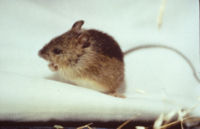 (Souris sauteuse des champs) |
Zapus hudsonius (Zimmermann Eberhard August Wilhelm von Zimmermann Eberhard August Wilhelm von Zimmermann was a German geographer and zoologist.Zimmermann was Professor of Natural Science at Brunswick. He wrote Specimen Zoologiae Geographicae Quadrupedum , one of the first works on the geographical distribution of mammals.... , 1780) |
Wet fields | Eastern Canada (except Anticosti island and Newfoundland) to Yukon |
|
| Western Jumping Mouse Western Jumping Mouse The Western Jumping Mouse , is a species of rodent in the Dipodidae family. It is found in Canada and the United States.... (Souris sauteuse de l'ouest) |
Zapus princeps (Allen, 1893) |
Prairies | Rockies and Prairies |
|
| Pacific Jumping Mouse Pacific Jumping Mouse The Pacific Jumping Mouse is a species of rodent in the family Dipodidae. It is found in Canada and the United States. Its natural habitats are temperate grassland and swamps.... (Souris sauteuse du Pacifique) |
Zapus trinotatus (Rhoads, 1893) |
Montane prairies | Southwestern British Columbia |
|
| Family Cricetidae Cricetidae The Cricetidae are a family of rodents in the large and complex superfamily Muroidea. It includes true hamsters, voles, lemmings, and New World rats and mice... : Cricetids |
||||
| Southern Red-backed Vole Southern Red-backed Vole The Southern Red-backed Vole or Gapper's Red-backed Vole is a small slender vole found in Canada and the northern United States... 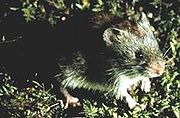 (Campagnol à dos roux de Gapper) |
Clethrionomys gapperi (Vigors Nicholas Aylward Vigors Nicholas Aylward Vigors was an Irish zoologist and politician.Vigors was born at Old Leighlin, County Carlow. He studied at Trinity College, Oxford. He served in the army during the Peninsular War from 1809 to 1811. He then returned to Oxford, graduating with a B.A. in 1815 and in 1817 with an... , 1830) |
Forests | Most of the provinces, except Newfoundland and Vancouver Island |
|
| Southern Red-backed Vole Southern Red-backed Vole The Southern Red-backed Vole or Gapper's Red-backed Vole is a small slender vole found in Canada and the northern United States... (Campagnol à dos roux boréal) |
Clethrionomys rutilus (Pallas Peter Simon Pallas Peter Simon Pallas was a German zoologist and botanist who worked in Russia.- Life and work :Pallas was born in Berlin, the son of Professor of Surgery Simon Pallas. He studied with private tutors and took an interest in natural history, later attending the University of Halle and the University... , 1779) |
Shrubby tundra | Mainland Arctic |
|
| Northern Collared Lemming Northern Collared Lemming The Northern Collared Lemming , sometimes called the Peary Land Collared Lemming in Canada, is a small North American lemming. At one time, it was considered to be a subspecies of the Arctic Lemming... (Lemming variable) |
Dicrostonyx groenlandicus (Traill Thomas Stewart Traill Thomas Stewart Traill was a Scottish physician, chemist, mineralogist, meteorologist, zoologist and scholar of medical jurisprudence.He was the grandfather of the physicist, meteorologist and geologist Robert Traill Omond.... , 1823) |
Tundra | Northern Arctic islands |
|
| Ungava Collared Lemming Ungava Collared Lemming The Ungava Collared Lemming or Labrador Collared Lemming, Dicrostonyx hudsonius is a small North American lemming.They have short chunky bodies covered with brownish-grey fur with a thin dark stripe along their back and a yellow line along their sides. They have small ears, short legs and a very... (Lemming d'Ungava) |
Dicrostonyx hudsonius (Pallas, 1778) |
Tundra | Northern Quebec |
|
| Victoria Collared Lemming
(—) |
Dicrostonyx kilangmiutak (Anderson John Anderson (zoologist) John Anderson was a Scottish anatomist and zoologist who worked in India.He was born in Edinburgh and graduated in medicine from the University of Edinburgh in 1861. His thesis however was in zoology... & Rand Austin L. Rand Austin Loomer Rand was a Canadian zoologist.He was born in Kentville, Nova Scotia in 1905 and grew up in nearby Wolfville, where he was mentored by the noted local ornithologist Robie W. Tufts... , 1945) |
Tundra | Mainland Arctic, Banks, Victoria and King Williams Islands |
|
| Ogilvie Mountains Collared Lemming Ogilvie Mountains Collared Lemming The Ogilvie Mountains Collared Lemming is a species of rodent in the family Cricetidae.It is found only in Canada.Its natural habitat is tundra.... (—) |
Dicrostonyx nunatakensis (Youngman, 1967) |
Montane tundra | Ogilvie Mountains |
|
| Richardson's Collared Lemming Richardson's Collared Lemming The Richardson's Collared Lemming, Dicrostonyx richardsoni is a small North American lemming. At one time, they were considered to be a subspecies of the Arctic Lemming, Dicrostonyx torquatus... (—) |
Dicrostonyx richardsoni (Merriam Clinton Hart Merriam Clinton Hart Merriam was an American zoologist, ornithologist, entomologist and ethnographer.Known as "Hart" to his friends, Dr. Clinton Hart Merriam was born in New York City in 1855. His father, Clinton Levi Merriam, was a U.S. congressman. He studied biology and anatomy at Yale University and... , 1900) |
Tundra | Arctic, roughly south of the Thelon River Basin |
|
| Sagebrush Vole Sagebrush Vole The Sagebrush Vole is a tiny vole found in western North America. This is the only member of genus Lemmiscus.... (Campagnol des sauges) |
Lemmiscus curtatus (Cope Edward Drinker Cope Edward Drinker Cope was an American paleontologist and comparative anatomist, as well as a noted herpetologist and ichthyologist. Born to a wealthy Quaker family, Cope distinguished himself as a child prodigy interested in science; he published his first scientific paper at the age of nineteen... , 1868) |
Sagebrush steppes | Southern Alberta and Saskatchewan |
|
| North American Brown Lemming North American Brown Lemming The North American brown lemming, Lemmus trimucronatus, is a small North American lemming. Originally called the Siberian Brown Lemming Lemmus sibiricus it was later decided that they formed two distinct species....  (Lemming brun) |
Lemmus trimucronatus (Richardson, 1825) |
Tundra of Nunavut, Northwest Territories and Yukon, also west coast of BC almost South to Vancouver Island |
|
|
| Rock Vole Rock Vole The Rock Vole is a medium-sized vole found in eastern North America. It is also called the Yellow-nosed Vole.... (Campagnol des rochers) |
Microtus chrotorrhinus (Miller, 1894) |
Rocky areas | Boreal Ontario and Quebec; southernmost Labrador; Gaspesia and northern New brunswick |
|
| Long-tailed Vole Long-tailed Vole The Long-tailed Vole is a small vole found in western North America. The Coronation Island Vole, once considered to be a separate species, is now believed to be a subspecies.... (Campagnol longicaude) |
Microtus longicaudus (Miller, 1894) |
Varied | Western Cordillera |
|
| Singing Vole Singing Vole The singing vole, Microtus miurus, is a medium-sized vole found in northwestern North America, including Alaska and northwestern Canada.-Physical characteristics:... 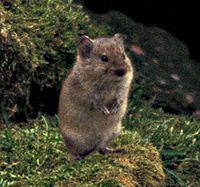 (Campagnol chanteur) |
Microtus miurus (Osgood Wilfred Hudson Osgood Wilfred Hudson Osgood was an American zoologist.Osgood was working as a biologist in the United States Department of Agriculture from 1897 to 1909. Then he moved to the Field Museum of Natural History in Chicago, where he was assistant curator of mammalogy and ornithology from 1909 to 1921, and... , 1901) |
Alpine tundra | Yukon and neighbouring Northwest Territory. |
|
| Montane Vole Montane Vole The Montane Vole is a species of rodent in the family Cricetidae.It is found in the western United States and British Columbia in Canada.-References:... (Campagnol montagnard) |
Microtus montanus (Peale, 1848) |
Shortgrass alpine prairies | Central south British Columbia |
|
| Prairie Vole Prairie Vole The Prairie Vole is a small vole found in central North America. The vole has long, coarse grayish-brown fur on the upper portion of the body and yellowish fur on the lower portion of the body... 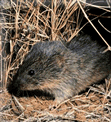 (Campagnol des prairies) |
Microtus ochrogaster (Wagner Johann Andreas Wagner Johann Andreas Wagner was a German palaeontologist, zoologist and archaeologist.Wagner was a professor at the University of Munich, and curator of the Zoologische Staatssammlung .... , 1842) |
Prairies | Prairie provinces |
|
| Tundra Vole Tundra Vole The Tundra Vole or Root Vole, Microtus oeconomus, is a medium-sized vole found in Northern and Central Europe, Asia, and northwestern North America, including Alaska and northwestern Canada... 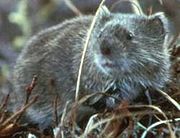 (Campagnol nordique) |
Microtus oeconomus (Pallas, 1776) |
Wet tundra | Western Arctic |
|
| Creeping Vole Creeping Vole The Creeping Vole is a species of rodent in the family Cricetidae.It is found in British Columbia in Canada and in California, Oregon and Washington in the United States.-References:... (Campagnol de l'oregon) |
Microtus oregoni (Bachman, 1839) |
Humid coniferous forest | Southern British Columbia |
|
| Meadow Vole Meadow Vole The Meadow Vole , sometimes called the Field Mouse or Meadow Mouse, is a North American vole found across Canada, Alaska and the northern United States. Its range extends further south along the Atlantic coast. One subspecies, the Florida Salt Marsh Vole , is found in Florida, and is classified as... 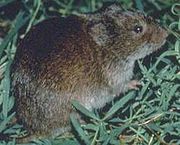 (Campagnol des champs) |
Microtus pennsylvanicus (Ord, 1815) |
Wet fields | All of Canada except Arctic and westernmost ranges |
|
| Woodland Vole Woodland Vole The Woodland Vole, Microtus pinetorum, is a small vole found in eastern North America. It is also known as the Pine Vole.-Description:...  (Campagnol sylvestre) |
Microtus pinetorum (Le Conte, 1830) |
Deciduous forests | Southernmost Ontario and Quebec |
|
| Water Vole Water Vole (North America) The Water Vole, Microtus richardsoni, is the largest North American vole. It is found in the northwestern United States and southern parts of western Canada... (Campagnol de Richardson) |
Microtus richardsoni (De Kay James Ellsworth De Kay James Ellsworth De Kay was an American zoologist.-Biography:... , 1842) |
Alpine prairies and streams | Cascades and southern Rockies |
|
| Townsend's Vole Townsend's Vole Townsend's Vole is a species of rodent in the family Cricetidae.It is found in British Columbia in Canada and in Washington and Oregon in the United States.Its natural habitat is temperate grassland.-References:... (Campagnol de Townsend) |
Microtus townsendii (Bachman, 1839) |
Saline marshes and fields | Vancouver Island, nearby islands and Fraser River delta |
|
| Taiga Vole Taiga Vole The Taiga Vole, Microtus xanthognathus, is a large vole found in northwestern North America, including Alaska and northwestern Canada. It is also sometimes called the Yellow-cheeked Vole or Chestnut-cheeked Vole.... (Campagnol à joues jaunes) |
Microtus xanthognathus (Leach William Elford Leach William Elford Leach FRS was an English zoologist and marine biologist.Leach was born at Hoe Gate, Plymouth, the son of a solicitor. At the age of twelve he went to school in Exeter, studying anatomy and chemistry. By this time he was already collecting marine samples from Plymouth Sound and along... , 1815) |
Forest streams | From southwester Hudson Bay through northern Prairies and Yukon |
|
| Muskrat Muskrat The muskrat , the only species in genus Ondatra, is a medium-sized semi-aquatic rodent native to North America, and introduced in parts of Europe, Asia, and South America. The muskrat is found in wetlands and is a very successful animal over a wide range of climates and habitats...  (Rat musqué) |
Ondatra zibethicus (Linnaeus, 1766) |
Wetlands | Most of Canada outside the Arctic and southwestern British Columbia |
|
| Western Heather Vole Western Heather Vole The Western Heather Vole, Phenacomys intermedius, is a small vole found in western North America. Until recently, the Eastern Heather Vole, Phenacomys ungava, was considered to be a subspecies.... (Campagnol des bruyères) |
Phenacomys intermedius (Merriam, 1889) |
Varied | British COlumbia |
|
| Eastern Heather Vole Eastern Heather Vole The Eastern Heather Vole, Phenacomys ungava, is a small North American vole. Until recently, this species was considered to belong to the same species as the Western Heather Vole, Phenacomys intermedius. It is also called the Ungava Vole.... (Phénacomys d'Ungava) |
Phenacomys ungava (Merriam, 1889) |
Varied | Quebec, Ontario and Labrador to southern Yukon |
|
| Northern Bog Lemming Northern Bog Lemming The Northern Bog Lemming, Synaptomys borealis is a small North American lemming. This is one of two species in genus Synaptomys, the other being the Southern Bog Lemming.... (Campagnol-lemming boréal) |
Synaptomys borealis (Richardson, 1828) |
Peatlands | Labrador to Alaska; Gaspesia and northern New Brunswick |
|
| Southern Bog Lemming Southern Bog Lemming The Southern Bog Lemming, Synaptomys cooperi is a small North American lemming. Its range overlaps with the other species in genus Synaptomys, the Northern Bog Lemming, in southeastern Canada but extends further south.... (Campagnol-lemming de Cooper) |
Synaptomys cooperi (Baird Spencer Fullerton Baird Spencer Fullerton Baird was an American ornithologist, ichthyologist and herpetologist. Starting in 1850 he was assistant-secretary and later secretary of the Smithsonian Institution in Washington, D.C... , 1857) |
Peatlands | Western Manitoba, central and southern Ontario and Quebec, New Brunswick, Nova Scotia |
|
| Bushy-tailed Woodrat Bushy-tailed Woodrat The Bushy-tailed Woodrat, Packrat, or Woodrat is a species of rodent in the family Cricetidae.It is found in Canada and the United States....  (Rat à queue touffue) |
Neotoma cinerea (Ord, 1815) |
Mountains | Western Cordillera |
|
| Northwestern Deer Mouse Northwestern Deer Mouse The Northwestern Deer Mouse or Keen's Mouse is a species of rodent in the family Cricetidae. It is found in British Columbia in Canada and in Alaska and Washington in the United States. It was named after the Rev. John Henry Keen in 1894.-References:*Musser, G. G. and M. D. Carleton. 2005.... (—) |
Peromyscus keeni (Rhoades, 1894) |
mild a rainy forests | West of the Coastal Mountains |
|
| White-footed Mouse White-footed mouse White-footed Mouse is a rodent native to North America. It ranges from Ontario, Quebec, Labrador and the Maritime Provinces to the southwest USA and Mexico. It is also known as the Woodmouse, particularly in Texas.Adults are in length, not counting the tail, which can add another . A young adult... (Souris à pattes blanches) |
Peromyscus leucopus (Rafinesque, 1818) |
Deciduous forests | Southern Alberta, Saskatchewan, Ontario, Quebec and Nova Scotia |
|
| Deer mouse Peromyscus maniculatus Peromyscus maniculatus is a rodent native to North America. It is most commonly called the Deer Mouse, although that name is common to most species of Peromyscus and is fairly widespread across the continent, with the major exception being the southeast United States and the far north.Like other... 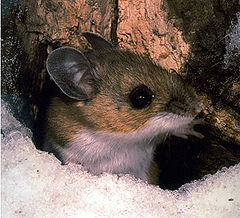 (Souris sylvestre) |
Peromyscus maniculatus (Wagner, 1845) |
Anywhere except wetlands | Much of Canada south of the tree line except Newfoundland |
|
| Western Harvest Mouse Western harvest mouse The Western Harvest Mouse is a small neotomine mouse native to southwest British Columbia, most of the western United States extending continuously to west Texas, northeast Arkansas, northwest Indiana, southwest Wisconsin, the interior of Mexico to Oaxaca...  (Souris-moissonneuse occidentale) |
Reithrodontomys megalotis (Baird, 1858) |
Prairies | Okanagan Valley (ssp. dychei), south of Alberta and Saskatchewann (ssp. megalotis) |
|
| Northern Grasshopper Mouse
(Souris à sauterelles) |
Onychomys leucogaster (Wied-Neuwied, 1841) |
Southern Prairies | Prairies |
|
Order Lagomorpha: Rabbits and pikas
The lagomorphsLagomorpha
The lagomorphs are the members of the taxonomic order Lagomorpha, of which there are two living families, the Leporidae , and the Ochotonidae...
comprise two families, Leporidae (hare
Hare
Hares and jackrabbits are leporids belonging to the genus Lepus. Hares less than one year old are called leverets. Four species commonly known as types of hare are classified outside of Lepus: the hispid hare , and three species known as red rock hares .Hares are very fast-moving...
s and rabbit
Rabbit
Rabbits are small mammals in the family Leporidae of the order Lagomorpha, found in several parts of the world...
s), and Ochotonidae (pika
Pika
The pika is a small mammal, with short limbs, rounded ears, and short tail. The name pika is used for any member of the Ochotonidae, a family within the order of lagomorphs, which also includes the Leporidae . One genus, Ochotona, is recognised within the family, and it includes 30 species...
s). They can resemble rodent
Rodent
Rodentia is an order of mammals also known as rodents, characterised by two continuously growing incisors in the upper and lower jaws which must be kept short by gnawing....
s, but differ in a number of physical characteristics, such as having four incisor
Incisor
Incisors are the first kind of tooth in heterodont mammals. They are located in the premaxilla above and mandible below.-Function:...
s in the upper jaw rather than two.
| Common name (French French language French is a Romance language spoken as a first language in France, the Romandy region in Switzerland, Wallonia and Brussels in Belgium, Monaco, the regions of Quebec and Acadia in Canada, and by various communities elsewhere. Second-language speakers of French are distributed throughout many parts... name) |
Species (Authority) |
Preferred habitat | Native range | Status |
|---|---|---|---|---|
| Family Ochotonidae: Pikas | ||||
| Collared Pika Collared Pika The Collared Pika is small alpine lagomorph that lives in boulderfields of central and southern Alaska , and in parts of Canada, including northern British Columbia, Yukon, and western parts of the Northwest Territories. It is closely related to the American Pika...  (Pica à collier) |
Ochotona collaris (Nelson, 1893) |
Mountains above the tree line | Rockies of the Yukon |
|
| American Pika American Pika The American pika , a diurnal species of pika, is found in the mountains of western North America, usually in boulder fields at or above the tree line. They are herbivorous, smaller relatives of rabbits and hares.-Description:...  (Pica d'Amérique) |
Ochotona princeps (Richardson, 1828) |
Mountains near the tree line | Southern British Columbia and Alberta |
|
| Family Leporidae Leporidae Leporids are the approximately 50 species of rabbits and hares which form the family Leporidae. The leporids, together with the pikas, constitute the mammalian order Lagomorpha. Leporids differ from pikas in having short furry tails, and elongated ears and hind legs... : Rabbits and hares |
||||
| Eastern Cottontail Eastern Cottontail The eastern cottontail is a New World cottontail rabbit, a member of the family Leporidae. It is one of the most common rabbit species in North America.-Distribution:... 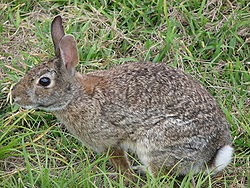 (Lapin à queue blanche) |
Sylvilagus floridanus (J. A. Allen, 1890) |
Open woodlands | Southern Manitoba, Saskatchewan Ontario and Quebec | |
| Mountain Cottontail Mountain Cottontail The Mountain Cottontail or Nuttall's Cottontail is a species of mammal in the Leporidae family. It is found in Canada and the United States.- Description :... (Lapin de Nuttall) |
Sylvilagus nuttallii (J. A. Allen, 1890) |
Dry plains | Southern Alberta and Saskatchewan, Okanagan and Similkameen valleys. |
|
| Snowshoe Hare Snowshoe Hare The Snowshoe Hare , also called the Varying Hare, or Snowshoe Rabbit, is a species of hare found in North America. It has the name "snowshoe" because of the large size of its hind feet and the marks its tail leaves. The animal's feet prevent it from sinking into the snow when it hops and walks... 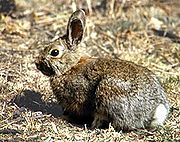 (Lièvre d'Amérique) |
Lepus americanus (Erxleben, 1777) |
Forest and marshes | Much of mainland Canada except southernmost Ontario |
|
| Arctic Hare Arctic Hare The arctic hare , or polar rabbit is a species of hare which is adapted largely to polar and mountainous habitats. The arctic hare survives with a thick coat of fur and usually digs holes under the ground or snow to keep warm and sleep...  (Lièvre arctique) |
Lepus arcticus (Ross, 1819) |
Tundra | Canadian Arctic (including Arctic Archipelago), Labrador, Newfoundland |
|
| White-tailed Jackrabbit White-tailed Jackrabbit The White-tailed Jackrabbit , also known as the Prairie Hare and the White Jack, is a hare found in western North America. Briefly reputed to have been extirpated , it is now clear from observations, roadkilled specimens and historical records that white-tailed jackrabbits are still extant in...  (Lièvre de Townsend) |
Lepus townsendii (Bachman, 1839) |
Fields | Southern prairies, Okanagan Valley |
|
Order Primate: Primates
The only primatePrimate
A primate is a mammal of the order Primates , which contains prosimians and simians. Primates arose from ancestors that lived in the trees of tropical forests; many primate characteristics represent adaptations to life in this challenging three-dimensional environment...
s that live in Canada are human beings. They are only distantly related to the New World monkey
New World monkey
New World monkeys are the five families of primates that are found in Central and South America: Callitrichidae, Cebidae, Aotidae, Pitheciidae, and Atelidae. The five families are ranked together as the Platyrrhini parvorder and the Ceboidea superfamily, which are essentially synonymous since...
s of Central and South America, and the species originated in east Africa. Humans first arrived in large numbers to Canada around 15,000 years ago from North Asia
North Asia
North Asia or Northern Asia is a subregion of Asia, consisting of the Asian portion of Russia.The Phillips Illustrated Atlas of the World 1988 defines it as being most of the former USSR, the part that is to the east of the Ural Mountains...
, and surged in migration starting 400 years ago from around the world, especially from Europe
Europe
Europe is, by convention, one of the world's seven continents. Comprising the westernmost peninsula of Eurasia, Europe is generally 'divided' from Asia to its east by the watershed divides of the Ural and Caucasus Mountains, the Ural River, the Caspian and Black Seas, and the waterways connecting...
.
| Common name (French French language French is a Romance language spoken as a first language in France, the Romandy region in Switzerland, Wallonia and Brussels in Belgium, Monaco, the regions of Quebec and Acadia in Canada, and by various communities elsewhere. Second-language speakers of French are distributed throughout many parts... name) |
Species (Authority) |
Preferred habitat | Native range | Status |
|---|---|---|---|---|
| Family | ||||
| Human being (Homme moderne) |
Homo sapiens sapiens (Linnaeus, 1758) |
urban areas or agricultural areas, but also found in other settings | everywhere, more common in the south |
|
Order Soricomorpha: Shrews and moles
SoricomorphsSoricomorpha
The order Soricomorpha is taxon within the class of mammals. In previous years it formed a significant group within the former order Insectivora...
are insectivorous mammals. Shrew
Shrew
A shrew or shrew mouse is a small molelike mammal classified in the order Soricomorpha. True shrews are also not to be confused with West Indies shrews, treeshrews, otter shrews, or elephant shrews, which belong to different families or orders.Although its external appearance is generally that of...
s closely resemble mice while mole
Mole (animal)
Moles are small cylindrical mammals adapted to a subterranean lifestyle. They have velvety fur; tiny or invisible ears and eyes; and short, powerful limbs with large paws oriented for digging. The term is especially and most properly used for the true moles, those of the Talpidae family in the...
s are stout-bodied burrowers.
| Common name (French French language French is a Romance language spoken as a first language in France, the Romandy region in Switzerland, Wallonia and Brussels in Belgium, Monaco, the regions of Quebec and Acadia in Canada, and by various communities elsewhere. Second-language speakers of French are distributed throughout many parts... name) |
Species (Authority) |
Preferred habitat | Native range | Status |
|---|---|---|---|---|
| Family Soricidae: Shrews | ||||
| Northern Short-tailed Shrew Northern Short-tailed Shrew The Northern Short-tailed Shrew is the largest shrew in the genus Blarina, and occurs in the northeastern region of North America. It is a semifossorial, highly active and voracious insectivore and is present in a variety of habitats. It is notable in that it is one of the few venomous mammals...  (Grande musaraigne) |
Blarina brevicauda (Say, 1823) |
Deciduous forests | Eastern Saskatchewan to Maritime provinces |
|
| North American Least Shrew
(Petite musaraigne) |
Cryptotis parva (Say, 1823) |
Fields, clearings and salt marshes | Long point, Ontario |
|
| Arctic Shrew Arctic Shrew The Arctic Shrew , also known as the Blackback Shrew or Saddlebacked Shrew, is a medium-sized shrew found in Canada and the northern United States. Separate species status has been proposed for the Maritime Shrew which is found in New Brunswick and Nova Scotia and had been considered to be a... (Musaraigne arctique) |
Sorex arcticus (Kerr Robert Kerr (writer) Robert Kerr FRS was a scientific writer and translator from Scotland.Kerr was born in Roxburghshire as the son of a jeweller. He studied medicine at the University of Edinburgh and practised at the Edinburgh Foundling Hospital as a surgeon... , 1792) |
Peatlands and marshes | From the Northwest Territory to central Quebec |
|
| Maritime Shrew Maritime Shrew The Maritime Shrew is a species of mammal in the family Soricidae. It is found in New Brunswick and Nova Scotia in Canada.... (Musaraigne des Maritimes) |
Sorex maritimensis (Smith, 1939) |
Peatlands and marshes | New Brunswick and Nova Scotia |
|
| Marsh Shrew Marsh Shrew The Marsh Shrew , also known as the Pacific Water Shrew, is a large North American shrew found near aquatic habitats, the largest member of genus Sorex in North America...  (Musaraigne de Bendire) |
Sorex bendirii (Smith, 1939) |
Coniferous forests | Fraser Valley |
|
| Masked Shrew Masked Shrew The Cinereus Shrew or Masked Shrew is a small shrew found in Alaska, Canada and the northern United States. This is the most widely distributed shrew in North America where it is also known as the Common Shrew.- Description :... 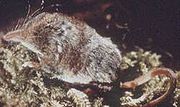 (Musaraigne cendrée) |
Sorex cinereus (Smith, 1939) |
Varied | Most of Mainland Canada except northernmost Quebec; Prince Edward and Cape Breton islands |
|
| Long-tailed Shrew Long-tailed Shrew The Long-tailed Shrew or Rock Shrew is a small North American shrew found in Atlantic Canada and the north-eastern United States.... (Musaraigne longicaude) |
Sorex dispar (Batchelder, 1911) |
Wet banks | Appalachians, Pennsylvania to New Brunswick |
|
| Smoky Shrew Smoky Shrew The Smoky Shrew, Sorex fumeus, is a medium-sized North American shrew found in eastern Canada and the northeastern United States.It is dull grey in colour with lighter underparts and a long tail which is brown on top and yellowish underneath. During winter, its fur is grey... 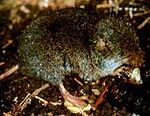 (Musaraigne fuligineuse) |
Sorex fumeus (Miller, 1895) |
Deciduous forests | Great lakes to Maritimes |
|
| Gaspé Shrew Gaspé Shrew The Gaspé Shrew is a North American shrew found on the Gaspé peninsula of Quebec, on Cape Breton Island in Nova Scotia and in New Brunswick... (Musaraigne de Gaspé) |
Sorex gaspensis (Anthony & Goodwin, 1924) |
Near forest streams | Gaspesia and northern New Brunswick; Cape Breton Island |
|
| Prairie Shrew Prairie Shrew The Prairie Shrew is a small shrew found in the Canadian prairies and midwestern United States. At one time, this species was considered to be a subspecies of the similar Cinereus Shrew, S. cinereus.... (Musaraigne des steppes) |
Sorex haydeni (Baird, 1857) |
Grassland | Southern Prairies |
|
| American Pygmy Shrew
(Musaraigne pygmée) |
Sorex hoyi (Baird, 1857) |
Forest clearings | Yukon and eastern Cordillera to Labrador and Maritimes |
|
| Merriam's Shrew Merriam's Shrew Merriam's Shrew is a species of mammal in the family Soricidae. It is endemic to the western United States and southern British Columbia in Canada.... (Musaraigne de Merriam) |
Sorex merriami (Dobson, 1890) |
Grasslands | Extreme southern British Columbia |
|
| Montane Shrew Montane Shrew The Montane Shrew is a species of mammal in the Soricidae family. It is found in Alaska, western Canada, the western United States and Mexico.... (Musaraigne sombre) |
Sorex monticolus (Merriam, 1890) |
Montane streams and marshes | Western Cordillera |
|
| American Water Shrew American Water Shrew The American Water Shrew or Northern Water Shrew, is a large North American shrew found in aquatic habitats. Some sources include the Glacier Bay Water Shrew, S. alaskanus, within this species.... 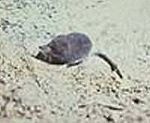 (Musaraigne palustre) |
Sorex palustris (Richardson, 1828) |
Lakes and marshes | Western Cordillera to Labrador and Maritimes except southern Prairies and southernmost Ontario |
|
| Preble's Shrew Preble's Shrew Preble's Shrew is a species of mammal in the family Soricidae. It is endemic to southern British Columbia in Canada and the western United States.... (Musaraigne de Preble) |
Sorex preblei (Jackson,1922) |
Montane streams and marshes | Southcentral British Columbia |
|
| Trowbridge's Shrew Trowbridge's Shrew Trowbridge's Shrew is a species of mammal in the Soricidae family. It is found in southern British Columbia in Canada and in Washington, Oregon, and California in the United States.... (Musaraigne de Trowbridge) |
Sorex trowbridgii (Baird, 1857) |
Coniferous forests | Lower Fraser Valley |
|
| Tundra Shrew Tundra Shrew The Tundra Shrew is a small shrew found in Alaska, the northern Yukon Territory, the MacKenzie Delta region of the Northwest Territories, extreme northwestern British Columbia and eastern Russia... (—) |
Sorex tundrensis (Merriam, 1900) |
Tundra | Yukon and Northwest territory |
|
| Barren Ground Shrew Barren Ground Shrew The Barren Ground Shrew is a small shrew found in northern Canada west of Hudson Bay and in Alaska. At one time, this species was considered to be a subspecies of the similar Cinereus Shrew . It is similar in appearance and thought to be closely related to the Saint Lawrence Island Shrew and... (—) |
Sorex ugyunak (Anderson Rudolph Martin Anderson Rudolph Martin Anderson was a Canadian zoologist and explorer.He was born in Decorah, Iowa in 1876, the son of John E.A. Anderson. He received a Ph.D... & Rand Austin L. Rand Austin Loomer Rand was a Canadian zoologist.He was born in Kentville, Nova Scotia in 1905 and grew up in nearby Wolfville, where he was mentored by the noted local ornithologist Robie W. Tufts... , 1945) |
Tundra | Mainland Arctic |
|
| Vagrant Shrew Vagrant Shrew The Vagrant Shrew is a medium-sized North American shrew. At one time, the Montane Shrew was considered to belong to the same species as this animal....  (Musaraigne errante) |
Sorex vagrans (Baird, 1857) |
Montane streams | Southern Cordillera |
|
| Family Talpidae Talpidae The family Talpidae includes the moles, shrew moles, desmans, and other intermediate forms of small insectivorous mammals of the order Soricomorpha... : Moles |
||||
| Star-nosed Mole Star-nosed mole The star-nosed mole is a small mole found in wet low areas of eastern Canada and the north-eastern United States, with records extending along the Atlantic coast as far as extreme southeastern Georgia...  (Condylure étoilé) |
Condylura cristata (Linnaeus, 1758) |
Wet forests | Manitoba, Ontario, Quebec, Labrador, New Brunswick and Nova Scotia |
|
| Coast Mole Coast Mole The Coast Mole or Pacific Mole is a medium-sized North American mole.It is found in forested and open areas with moist soils along the Pacific coast from southwestern British Columbia to central California.... (Taupe du Pacifique) |
Scapanus orarius (True Frederick W. True Frederick William True was an American biologist, the first head curator of biology at the United States National Museum, now part of the Smithsonian Institution.... , 1896) |
Alpine coniferous forest | Southwestern British Columbia |
|
| Townsend's Mole Townsend's Mole The Townsend's Mole, Scapanus townsendii, is the largest North American mole.It is found in open lowland areas and open wooded areas with moist soils along the Pacific coast from southwestern British Columbia to northwestern California... (Taupe de Townsend) |
Scapanus townsendii (Bachman, 1839) |
Fields | Southwestern British Columbia |
|
Shrew-mole
 (Taupe de Townsend) |
Neurotrichus gibbsii (Baird, 1858) |
Banks | Southwestern British Columbia |
|
| Eastern Mole Eastern Mole The eastern mole or common mole is a medium-sized, overall grey North American mole and the only member of the genus Scalopus. Its large, hairless, spade shaped forefeet are adapted for digging... (Taupe à queue glabre) |
Scalopus aquaticus (Linnaeus, 1758) |
Open woodlands | Point Pelee area |
|
| Hairy-tailed Mole Hairy-tailed Mole The Hairy-tailed Mole , also known as Brewer's Mole, is a medium-sized North American mole. It is the only member of the genus Parascalops.... (Taupe à queue velue) |
Parascalops breweri (Bachman, 1842) |
Dry loose soils | Southern Quebec and Ontario |
|
Order Chiroptera: Bats
Chiropteras' most distinguishing feature is that their forelimbs are developed as wings, making them the only mammals in the world naturally capable of flight. Bat species account for about 20% of all mammals.| Common name (French French language French is a Romance language spoken as a first language in France, the Romandy region in Switzerland, Wallonia and Brussels in Belgium, Monaco, the regions of Quebec and Acadia in Canada, and by various communities elsewhere. Second-language speakers of French are distributed throughout many parts... name) |
Species (Authority) |
Preferred habitat | Native range | Status |
|---|---|---|---|---|
| Family Vespertilionidae: Vesper bats | ||||
| Silver-haired bat Silver-Haired Bat The Silver-haired Bat is a species of vesper bat in the family Vespertilionidae and the only member of the genus Lasionycteris.- Habitat :...  (Chauve-souris argentée) |
Lasionycteris noctivagans (La Conte, 1831) |
Deciduous forest lakes | All of southern Canada except Gaspesia and northern Maritimes |
|
| California Myotis California Myotis The California Myotis is a species of vesper bat in the Vespertilionidae family.It is found in British Columbia in Canada, Guatemala, Mexico, and in the western United States, including California....  (Chauve-souris de Californie) |
Myotis californicus (Audubon John James Audubon John James Audubon was a French-American ornithologist, naturalist, and painter. He was notable for his expansive studies to document all types of American birds and for his detailed illustrations that depicted the birds in their natural habitats... & Bachman, 1842) |
West Coast forests | West Coast and Okanagan Valley |
|
| Western Small-footed Myotis Western Small-footed Myotis The Western Small-Footed Bat , also known as the Western Small-Footed Myotis, is a species of vesper bat in the Vespertilionidae family.It can be found in Canada, Mexico, and the United States.... (Chauve-souris pygmée de l'Ouest) |
Myotis ciliolabrum (Merriam, 1886) |
Dry areas | Southern Alberta and Saskatchewan |
|
| Long-eared Myotis Long-eared Myotis The Long-eared Myotis is a species of vesper bat. It can be found in western Canada, the western United States, and Baja California in Mexico.... (Chauve-souris à longues oreilles) |
Myotis evotis (H. Allen, 1864) |
Varied | Southern British Columbia, Alberta and Saskatchewan |
|
| Keen's Myotis Keen's Myotis Keen's Myotis is a species of vesper bat in the Vespertilionidae family.It is found in British Columbia in Canada and in Washington and Alaska in the United States. It is named after the Rev... (Chauve-souris de Keen) |
Myotis keenii (Merriam, 1895) |
Forests | West Coast |
|
| Eastern small-footed myotis Eastern Small-footed Myotis The Eastern Small-Footed Myotis or Eastern Small-footed Bat is a species of vesper bat in the family Vespertilionidae. It can be found in Ontario and Quebec in Canada and in the eastern United States... (Chauve-souris pygmée de l'Est) |
Myotis leibii (Audubon & Bachman, 1842) |
Montane forests | Southern and south-central Ontario, southwestern Quebec |
|
| Little brown bat Little brown bat The little brown bat is a species of the genus Myotis , one of the most common bats of North America... 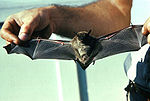 (Petite chauve-souris brune) |
Myotis lucifugus (La Conte, 1831) |
Varied, including cities | Yukon to Atlantic Canada |
|
| Northern long-eared myotis Northern long-eared myotis The Northern long-eared myotis is a small bat, typically 5-10 g and 84 mm in total length . The fur is dull brown on the dorsum and yellowish on the venter... 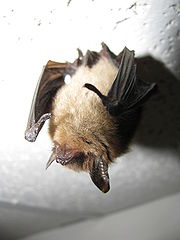 (—) |
Myotis septentrionalis (Trouessart Édouard Louis Trouessart Édouard Louis Trouessart was a French zoologist. He discovered the dust mite.... , 1897) |
Forests | Central to Eastern Canada |
|
| Fringed Myotis Fringed Myotis The Fringed Myotis is a species of vesper bat in the Vespertilionidae family.It is found in British Columbia in Canada, Mexico, and the western United States.... (Chauve-souris à queue frangée) |
Myotis thysanodes (Miller, 1897) |
White pines forest | Southcentral British Columbia |
|
| Long-legged Myotis Long-legged Myotis The Long-Legged Myotis is a species of vesper bat in the Vespertilionidae family.It can be found in Alberta and British Columbia in Canada, Mexico, and the western United States....  (Chauve-souris à longues pattes) |
Myotis volans (H. Allen, 1866) |
Varied | British Columbia and Alberta |
|
| Yuma Myotis Yuma Myotis The Yuma Myotis is a species of vesper bat in the Vespertilionidae family. Yuma Myotis occur in a variety of western lowland habitats where it forages for insects just above the surface of slow moving water. It eats a variety of soft-bodied insects, primarily moths. It is found in British Columbia... (Chauve-souris de Yuma) |
Myotis yumanensis (H. Allen, 1864) |
Open areas | West Coast and Okanagan Valley |
|
| Pallid bat Pallid bat The Pallid Bat is a species of bat that ranges from western Canada to central Mexico. It is the sole species of its genus and is closely related to Van Gelder's Bat , which is sometimes included in Antrozous... 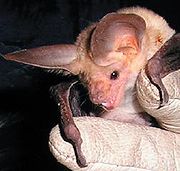 (Chauve-souris blonde) |
Antrozous pallidus (LeConte John Lawrence LeConte John Lawrence LeConte was the most important American entomologist of the 19th century, responsible for naming and describing approximately half of the insect taxa known in the United States during his lifetime, including some 5,000 species of beetles... , 1856) |
Dry plains | British Columbia |
|
| Big brown bat Big brown bat The Big Brown Bat is larger in size than comparative species of bats, from about 4 to 5 inches in body length, with a 11-13 inch wingspan and weighing 1/2 to 5/8 ounce. The fur is moderately long, and shiny brown... (Grande chauve-souris brune) |
Eptesicus fuscus (Palisot de Beauvois Palisot de Beauvois Ambroise Marie François Joseph Palisot, Baron de Beauvois 27 July 1752 Arras - 21 January 1820 Paris, was a French naturalist.Palisot collected insects in Oware, Benin, Saint Domingue, and the United States, during the period 1786 – 1797. Trained as a botanist, Palisot published a significant... , 1796) |
Varied, including cities | British Columbia to southern Quebec and New Brunswick |
|
| Spotted bat Spotted bat The Spotted bat , is a bat species from the family of vesper bats.-Description:The spotted bat was first described by zoologist Joel Asaph Allen from the American Museum of Natural History in 1891. It can reach a length of 12 cm and a wingspan of 35 cm. The weight is about 15 g. It has... (Oreillard maculé) |
Euderma maculatum (J. A. Allen, 1891) |
Near waterways | Inner British Columbia |
|
Western Red Bat
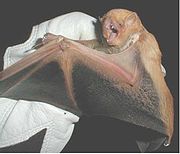 (Chauve-souris rousse de l'Ouest) |
Lasiurus blossevillii (Lesson and Garnot, 1826) |
Open spaces and cities | Southwestern British Columbia |
|
| Eastern Red Bat Eastern Red Bat The Eastern Red Bat is a species of bat from the family Vespertilionidae. See also the Desert red bat , a related species.... 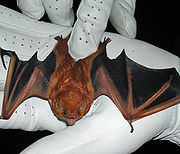 (Chauve-souris rousse de l'Est) |
Lasiurus borealis (Müller Otto Friedrich Müller Otto Friedrich Müller, also Mueller was a Danish naturalist.-Biography:Müller was born in Copenhagen. He was educated for the church, became tutor to a young nobleman, and after several years' travel with him settled in Copenhagen in 1767, and married a lady of wealth.His first important works,... , 1776) |
Open spaces and cities | Alberta to southern Maritimes |
|
| Hoary Bat Hoary bat The hoary bat is a species of bat in the vesper bat family, Vespertilionidae. It occurs throughout most of North America and much of South America, with disjunct populations in the Galapagos and Hawaiian Islands...  (Chauve-souris cendré) |
Lasiurus cinereus (Palisot de Beauvois, 1796) |
Forests | British Columbia to northern Hudson Bay and Maritimes |
|
| Eastern Pipistrelle Eastern Pipistrelle The Tricolored Bat is a species of bat that is widely distributed throughout the eastern parts of North America, ranging west until Kansas and Texas, from Honduras up north until southern Ontario...  (Pipistrelle de l'Est) |
Pipistrellus subflavus (F. Cuvier Frédéric Cuvier Frédéric Cuvier was a French zoologist. He was the younger brother of noted naturalist and zoologist Georges Cuvier.... , 1832) |
Forest, fields and waterways | Southern Ontario, Quebec and Maritimes |
|
| Townsend's Big-eared Bat Townsend's big-eared bat Townsend's Big-Eared Bat is a species of vesper bat in the Vespertilionidae family.- Description :The Townsend's Big-Eared Bat is a medium-sized bat with extremely long, flexible ears and small yet noticeable lumps on each side of the snout. Its upperparts are similar to dark brown on the back,...  (Oreillard de Townsend) |
Corynorhinus townsendii (Cooper, 1837) |
Open woodlands | Southern British Columbia |
|
Order Cetacea: Cetaceans
CetaceaCetacea
The order Cetacea includes the marine mammals commonly known as whales, dolphins, and porpoises. Cetus is Latin and is used in biological names to mean "whale"; its original meaning, "large sea animal", was more general. It comes from Ancient Greek , meaning "whale" or "any huge fish or sea...
s includes whale
Whale
Whale is the common name for various marine mammals of the order Cetacea. The term whale sometimes refers to all cetaceans, but more often it excludes dolphins and porpoises, which belong to suborder Odontoceti . This suborder also includes the sperm whale, killer whale, pilot whale, and beluga...
s, dolphin
Dolphin
Dolphins are marine mammals that are closely related to whales and porpoises. There are almost forty species of dolphin in 17 genera. They vary in size from and , up to and . They are found worldwide, mostly in the shallower seas of the continental shelves, and are carnivores, mostly eating...
s and porpoise
Porpoise
Porpoises are small cetaceans of the family Phocoenidae; they are related to whales and dolphins. They are distinct from dolphins, although the word "porpoise" has been used to refer to any small dolphin, especially by sailors and fishermen...
s. They are the mammals most fully adapted to aquatic
Aquatic adaptation
Several animal groups have undergone aquatic adaptation, going from being purely terrestrial animals to living at least part of the time in water. The adaptations in early speciation tend to develop as the animal ventures into water in order to find available food. As successive generations spend...
life with a spindle-shaped nearly hairless body, protected by a thick layer of blubber, and forelimbs and tail modified to provide propulsion underwater.
| Common name (French French language French is a Romance language spoken as a first language in France, the Romandy region in Switzerland, Wallonia and Brussels in Belgium, Monaco, the regions of Quebec and Acadia in Canada, and by various communities elsewhere. Second-language speakers of French are distributed throughout many parts... name) |
Species (Authority) |
Preferred habitat | Native range | Status |
|---|---|---|---|---|
| Family Balaenidae Balaenidae Balaenidae is a family of mysticete whales that contains two living genera. Commonly called the right whales as it contains mainly right whale species... : Right Whales |
||||
| Bowhead whale Bowhead Whale The bowhead whale is a baleen whale of the right whale family Balaenidae in suborder Mysticeti. A stocky dark-colored whale without a dorsal fin, it can grow to in length. This thick-bodied species can weigh to , second only to the blue whale, although the bowhead's maximum length is less than...  (Baleine boréale) |
Balaena mysticetus (Linnaeus, 1758) |
Polar ice shelf in winter, coastal waters in the summer. | Arctic Ocean |
|
| North Atlantic Right Whale North Atlantic Right Whale The North Atlantic right whale which means "good, or true, whale of the ice") is a baleen whale, one of three right whale species belonging to the genus Eubalaena, formerly classified as a single species. With only 400 in existence, North Atlantic right whales are among the most endangered whales... 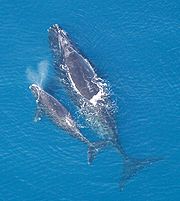 (Baleine franche) |
Eubalaena glacialis (Linnaeus, 1758) |
Temperate coast waters | North Atlantic |
|
| North Pacific Right Whale North Pacific Right Whale The North Pacific right whale is a very large, robust baleen whale species that is now extremely rare and endangered. The Northeast Pacific subpopulation, that summers in the southeastern Bering Sea and Gulf of Alaska, may have no more than 50 animals... 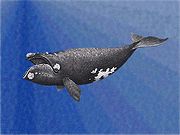 (Baleine franche) |
Eubalaena japonica (Lacépède, 1818) |
North Pacific |
|
|
| Family Balaenopteridae: Rorquals | ||||
| Northern Minke Whale
(Petit rorqual) |
Balaenoptera acutorostrata (Lacépède, 1804) |
Temperate or polar seas. | Northern Atlantic and Pacific |
|
| Sei Whale Sei Whale The sei whale , Balaenoptera borealis, is a baleen whale, the third-largest rorqual after the blue whale and the fin whale. It inhabits most oceans and adjoining seas, and prefers deep offshore waters. It avoids polar and tropical waters and semi-enclosed bodies of water...  (Rorqual boréal) |
Balaenoptera borealis (Lesson René-Primevère Lesson René Primevère Lesson was a French surgeon, naturalist, ornithologist, and herpetologist.Lesson was born at Rochefort, and at the age of sixteen he entered the Naval Medical School there... , 1828) |
Temperate seas. | Atlantic and Pacific oceans |
Pacific
Atlantic
|
| Blue Whale Blue Whale The blue whale is a marine mammal belonging to the suborder of baleen whales . At in length and or more in weight, it is the largest known animal to have ever existed.... 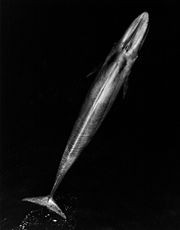 (Rorqual bleu) |
Balaenoptera musculus (Linnaeus, 1758) |
Temperate and polar waters. | Atlantic and Pacific oceans | North Pacific
North Atlantic
|
| Fin Whale Fin Whale The fin whale , also called the finback whale, razorback, or common rorqual, is a marine mammal belonging to the suborder of baleen whales. It is the second longest whale and the sixth largest living animal after the blue whale, bowhead whale, and right whales, growing to nearly 27 metres long...  (Rorqual commun) |
Balaenoptera physalus (Linnaeus, 1758) |
High sea. | Atlantic and Pacific oceans |
|
| Humpback Whale Humpback Whale The humpback whale is a species of baleen whale. One of the larger rorqual species, adults range in length from and weigh approximately . The humpback has a distinctive body shape, with unusually long pectoral fins and a knobbly head. It is an acrobatic animal, often breaching and slapping the...  (Baleine à bosse) |
Megaptera novaeangliae (Borowski, 1781) |
Coastal waters, often penetrates estuaries. | Atlantic and Pacific oceans |
|
| Family Eschrichtiidae: Grey Whale | ||||
| Gray Whale Gray Whale The gray whale, Eschrichtius robustus, is a baleen whale that migrates between feeding and breeding grounds yearly. It reaches a length of about , a weight of , and lives 50–70 years. The common name of the whale comes from the gray patches and white mottling on its dark skin. Gray whales were...  (Baleine grise) |
Eschrichtius robustus (Lilljebor Wilhelm Lilljeborg Wilhelm Lilljeborg was a Swedish zoologist. He is particularly known for his work on the Cladocera of Sweden, and on the Balaenoptera. Lilljeborg was a member of the Royal Swedish Academy of Sciences from 1861.-References:... , 1861) |
Temperate continental shelf waters. | Pacific Coast | Eastern Pacific population
Atlantic population
|
| Family Monodontidae Monodontidae The cetacean family Monodontidae comprises two unusual whale species, the narwhal, in which the male has a long tusk, and the white beluga whale... : Narwhal and Beluga |
||||
| Narwhal Narwhal The narwhal, Monodon monoceros, is a medium-sized toothed whale that lives year-round in the Arctic. One of two living species of whale in the Monodontidae family, along with the beluga whale, the narwhal males are distinguished by a characteristic long, straight, helical tusk extending from their...  (Narval) |
Monodon Monoceros (Linnaeus, 1758) |
Edge of Arctic ice sheet. | Eastern Arctic Ocean |
|
Beluga (Bélouga) |
Delphinapterus leucas (Pallas, 1776) |
Arctic coast waters. Often swim deep up rivers. | Eastern and Western Arctic Ocean |
|
| Family Phocoenidae: Porpoises | ||||
| Harbour Porpoise Harbour Porpoise The harbour porpoise is one of six species of porpoise. It is one of the smallest marine mammals. As its name implies, it stays close to coastal areas or river estuaries, and as such, is the most familiar porpoise to whale watchers. This porpoise often ventures up rivers, and has been seen... 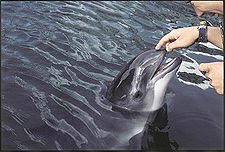 (Marsouin commun) |
Phocoena phocoena (Linnaeus, 1758) |
East and West Coast |
|
|
| Dall's Porpoise Dall's Porpoise Dall's porpoise is a species of porpoise found on the North Pacific. It came to worldwide attention in the 1970s when it was disclosed for the first time to the public that salmon fishing trawls were killing a lot, thousands of Dall's porpoises and other cetaceans each year by accidentally...  (Marsouin de Dall) |
Phocoenoides dalli (True Frederick W. True Frederick William True was an American biologist, the first head curator of biology at the United States National Museum, now part of the Smithsonian Institution.... , 1885) |
Continental shelf. | North Pacific |
|
| Family Physeteridae: Sperm Whale | ||||
| Sperm Whale Sperm Whale The sperm whale, Physeter macrocephalus, is a marine mammal species, order Cetacea, a toothed whale having the largest brain of any animal. The name comes from the milky-white waxy substance, spermaceti, found in the animal's head. The sperm whale is the only living member of genus Physeter... 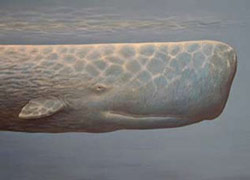 (Cachalot) |
Physeter macrocephalus (Linnaeus, 1758) |
Very deep waters. | Pacific and Atlantic Oceans. Only migrating males are found in Canadian waters. |
|
| Family Ziphidae: Beaked Whales | ||||
| Cuvier's Beaked Whale Cuvier's Beaked Whale Cuvier's beaked whale is the most widely distributed of all the beaked whales. It is the only member of the genus Ziphius. Another common name for the species is goose-beaked whale because its head is said to be shaped like the beak of a goose. Georges Cuvier first described it in 1823 from part... 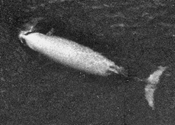 (Baleine à bec de Cuvier) |
Ziphius cavirostris (G. Cuvier Georges Cuvier Georges Chrétien Léopold Dagobert Cuvier or Jean Léopold Nicolas Frédéric Cuvier , known as Georges Cuvier, was a French naturalist and zoologist... , 1823) |
Uncertain | North Pacific and Atlantic |
|
| Baird's Beaked Whale (Grande baleine à bec) |
Berardius bairdii (Stejneger Leonhard Hess Stejneger Leonhard Hess Stejneger was a Norwegian-born American ornithologist, herpetologist and zoologist. Stejneger specialized in vertebrate natural history studies. He gained his greatest reputation with reptiles and amphibians.... , 1883) |
Near continental shelf cliffs | North Pacific |
|
| Bottlenose whale Bottlenose whale The Northern bottlenose whale is a species of the ziphiid family, one of two members of the Hyperoodon genus. The northern bottlenose was hunted heavily by Norway and Britain in the 19th and early 20th centuries... (Baleine à bec commune) |
Hyperoodon ampullatus (Forster Johann Reinhold Forster Johann Reinhold Forster was a German Lutheran pastor and naturalist of partial Scottish descent who made contributions to the early ornithology of Europe and North America... , 1770) |
Subarctic waters | North Atlantic and part of Arctic |
|
| Sowerby's Beaked Whale Sowerby's Beaked Whale Sowerby's beaked whale , also known as the North Atlantic/North Sea beaked whale, was the first beaked whale to be described. James Sowerby, an English naturalist and artist, first described the species in 1804 from a skull obtained from a male that had stranded in the Moray Firth, Scotland, in 1800... 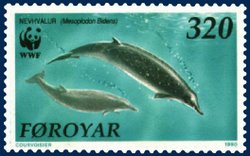 (Baleine à bec de Sowerby) |
Mesoplodon bidens (Sowerby James Sowerby James Sowerby was an English naturalist and illustrator. Contributions to published works, such as A Specimen of the Botany of New Holland or English Botany, include his detailed and appealing plates... , 1804) |
Deep ocean. | Temperate North Atlantic |
|
| Hubbs' Beaked Whale Hubbs' Beaked Whale Hubbs' beaked whale was initially thought to be an Andrews' beaked whale when discovered by ichthyologist Carl Hubbs; however, it was named in his honor when it was discovered to be a new species. This species has the typical dentition found in the genus, but its main outstanding features are a... (Baleine à bec de Moore) |
Mesoplodon carlhubbsi (Moore, 1963) |
Temperate waters | North Pacific |
|
| Stejneger's Beaked Whale Stejneger's Beaked Whale Stejneger's beaked whale , sometimes known as the Bering Sea beaked whale or the Saber-toothed whale, is a poorly-known member of the genus Mesoplodon inhabiting the northern North Pacific Ocean. Leonhard Hess Stejneger initially described the species in 1885 from a skull, and nothing more of the... (Baleine à bec de Stejneger) |
Mesoplodon stejnegeri (True, 1885 ) |
Cold, high sea. | North Pacific |
|
| Family Delphinidae: Oceanic Dolphins | ||||
| Bottlenose Dolphin Bottlenose Dolphin Bottlenose dolphins, the genus Tursiops, are the most common and well-known members of the family Delphinidae, the family of oceanic dolphins. Recent molecular studies show the genus contains two species, the common bottlenose dolphin and the Indo-Pacific bottlenose dolphin , instead of one... 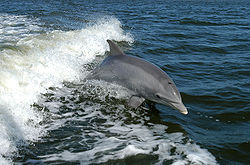 (Grand dauphin) |
Tursiops truncatus (Montagu, 1821) |
Coastal waters. | Occasional in the Maritimes |
|
| Short-beaked common dolphin Short-beaked Common Dolphin The short-beaked common dolphin is a species of common dolphin. It has a larger range than the long-beaked common dolphin , occurring throughout warm-temperate and tropical oceans, with the possible exception of the Indian Ocean... 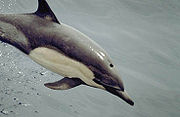 (Dauphin commun à bec court) |
Delphinus delphis (Linnaeus, 1758) |
Temperate high sea | Atlantic and Pacific Continental shelves |
|
| Atlantic White-sided Dolphin Atlantic White-sided Dolphin The Atlantic White-sided Dolphin is a distinctively coloured dolphin found in the cool to temperate waters of the North Atlantic Ocean.-Taxonomy:... (Dauphin à flancs blancs) |
Lagenorhynchus acutus (Gray, 1828) |
Temperate high sea. | North Atlantic |
|
| Pacific White-sided Dolphin Pacific White-sided Dolphin The Pacific White-sided Dolphin is a very active dolphin found in the cool to temperate waters of the North Pacific Ocean.-Taxonomy:...  (Dauphin à flancs blancs du pacifique) |
Lagenorhynchus obliquidens (Gill, 1865) |
Temperate and subarctic seas. | North Pacific |
|
| White-beaked Dolphin White-beaked Dolphin The White-beaked dolphin is a marine mammal belonging to the family Delphinidae in the suborder Odontoceti .-Taxonomy:...  (Dauphin à bec blanc) |
Lagenorhynchus albirostris (Gray, 1846) |
High, cold sea. | North Atlantic |
|
| Orca Orca The killer whale , commonly referred to as the orca, and less commonly as the blackfish, is a toothed whale belonging to the oceanic dolphin family. Killer whales are found in all oceans, from the frigid Arctic and Antarctic regions to tropical seas... 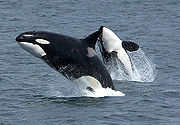 (Épaulard or Orque) |
Orcinus orca (Linnaeus, 1758) |
Prefers coastal waters. | Atlantic, Pacific and parts of the Arctic |
|
| Short-finned Pilot Whale Short-finned Pilot Whale The Short-finned Pilot Whale is one of the two species of cetacean in the genus Globicephala. It is part of the oceanic dolphin family , though its behaviour is closer to that of the larger whales....  (Globicéphale du Pacifique) |
Globicephala macrorhynchus (Gray, 1846) |
Varied. | Pacific Ocean |
|
| Long-finned Pilot Whale Long-finned Pilot Whale The long-finned pilot whale is one of the two species of cetacean in the genus Globicephala. It belongs to the oceanic dolphin family , though its behavior is closer to that of the larger whales.-Description:... (Globicéphale de l'Atlantique) |
Globicephala melas (Traill Thomas Stewart Traill Thomas Stewart Traill was a Scottish physician, chemist, mineralogist, meteorologist, zoologist and scholar of medical jurisprudence.He was the grandfather of the physicist, meteorologist and geologist Robert Traill Omond.... , 1809) |
Varied. | North Atlantic |
|
Order Carnivora: Carnivores
The CarnivoraCarnivora
The diverse order Carnivora |Latin]] carō "flesh", + vorāre "to devour") includes over 260 species of placental mammals. Its members are formally referred to as carnivorans, while the word "carnivore" can refer to any meat-eating animal...
s include over 260 species, the majority of which eat meat as their primary dietary item. Carnivores have a characteristic skull shape and dentition.
| Common name (French French language French is a Romance language spoken as a first language in France, the Romandy region in Switzerland, Wallonia and Brussels in Belgium, Monaco, the regions of Quebec and Acadia in Canada, and by various communities elsewhere. Second-language speakers of French are distributed throughout many parts... name) |
Species (Authority) |
Preferred habitat | Native range | Status |
|---|---|---|---|---|
| Family Felidae Felidae Felidae is the biological family of the cats; a member of this family is called a felid. Felids are the strictest carnivores of the thirteen terrestrial families in the order Carnivora, although the three families of marine mammals comprising the superfamily pinnipedia are as carnivorous as the... : Felines |
||||
Canadian Lynx (Lynx du Canada) |
Lynx canadensis (Kerr Robert Kerr (writer) Robert Kerr FRS was a scientific writer and translator from Scotland.Kerr was born in Roxburghshire as the son of a jeweller. He studied medicine at the University of Edinburgh and practised at the Edinburgh Foundling Hospital as a surgeon... , 1792) |
Forests | Most of Canada |
|
| Bobcat Bobcat The bobcat is a North American mammal of the cat family Felidae, appearing during the Irvingtonian stage of around 1.8 million years ago . With twelve recognized subspecies, it ranges from southern Canada to northern Mexico, including most of the continental United States... 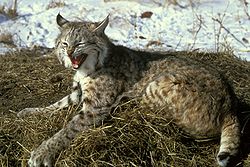 (Lynx roux) |
Lynx rufus (Schreber Johann Christian Daniel von Schreber Johann Christian Daniel von Schreber , often styled I.C.D. von Schreber, was a German naturalist.-Career:He was elected Professor of Materia medica at the University of Erlangen in 1769.... , 1777) |
Varied | Southern Canada |
|
Cougar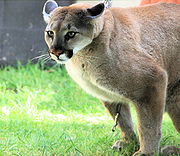 (Cougar) |
Puma concolor (Linnaeus, 1771) |
Mountain, marshes, dense forests | Mountainous regions of Alberta and British Columbia |
Eastern Population
|
| Family Canidae Canidae Canidae is the biological family of carnivorous and omnivorous mammals that includes wolves, foxes, jackals, coyotes, and domestic dogs. A member of this family is called a canid . The Canidae family is divided into two tribes: Canini and Vulpini... : Canines |
||||
| Arctic fox Arctic fox The arctic fox , also known as the white fox, polar fox or snow fox, is a small fox native to Arctic regions of the Northern Hemisphere and is common throughout the Arctic tundra biome. The Greek word alopex, means a fox and Vulpes is the Latin version... 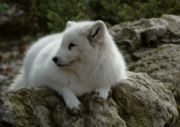 (Renard arctique or polaire) |
Alopex lagopus (Linnaeus, 1758) |
Tundra | Northern Canada |
|
| Swift Fox Swift Fox The swift fox is a small light orange-tan fox around the size of a domestic cat found in the western grasslands of North America, such as Colorado, New Mexico and Texas. It also lives in Manitoba, Saskatchewan and Alberta in Canada, where it was previously extirpated... 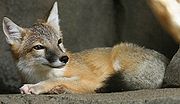 (Renard véloce) |
Vulpes velox (Say, 1823) |
Desert and dry prairie | Southern Prairie Provinces |
|
| Red Fox Red Fox The red fox is the largest of the true foxes, as well as being the most geographically spread member of the Carnivora, being distributed across the entire northern hemisphere from the Arctic Circle to North Africa, Central America, and the steppes of Asia... 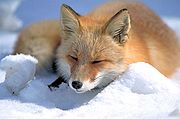 (Renard roux) |
Vulpes vulpes (Linnaeus, 1758) |
Varied | All of Canada except part of the Arctic Islands and West Coast |
|
| Gray Fox Gray Fox The gray fox is a mammal of the order Carnivora ranging throughout most of the southern half of North America from southern Canada to the northern part of South America...  (Renard gris) |
Urocyon cinereoargenteus (Schreber, 1775) |
Varied | Southern Manitoba, Ontario and Quebec |
|
| Coyote Coyote The coyote , also known as the American jackal or the prairie wolf, is a species of canine found throughout North and Central America, ranging from Panama in the south, north through Mexico, the United States and Canada...  (Coyote) |
Canis latrans (Say, 1823) |
Varied | Rockies through southern prairies to southwestern Quebec. |
|
| Gray Wolf Gray Wolf The gray wolf , also known as the wolf, is the largest extant wild member of the Canidae family...  (Loup) |
Canis lupus (Say, 1823) |
Varied | All of Canada except Anticosti and Prince Edward Islands. Going extinct in several areas. |
|
| Family Ursidae: Bears | ||||
| American black bear American black bear The American black bear is a medium-sized bear native to North America. It is the continent's smallest and most common bear species. Black bears are omnivores, with their diets varying greatly depending on season and location. They typically live in largely forested areas, but do leave forests in...  (Ours noir) |
Ursus americanus (Pallas Peter Simon Pallas Peter Simon Pallas was a German zoologist and botanist who worked in Russia.- Life and work :Pallas was born in Berlin, the son of Professor of Surgery Simon Pallas. He studied with private tutors and took an interest in natural history, later attending the University of Halle and the University... , 1780) |
Varied | Most of Canada except Arctic and Prince Edward Island. |
|
| Brown Bear Brown Bear The brown bear is a large bear distributed across much of northern Eurasia and North America. It can weigh from and its largest subspecies, the Kodiak Bear, rivals the polar bear as the largest member of the bear family and as the largest land-based predator.There are several recognized...  (Ours brun) |
Ursus arctos (Linnaeus, 1758 ) |
Open spaces, mostly alpine and Arctic tundra | Rockies, mainland Northwest Territory and Nunavut. |
|
| Polar Bear Polar Bear The polar bear is a bear native largely within the Arctic Circle encompassing the Arctic Ocean, its surrounding seas and surrounding land masses. It is the world's largest land carnivore and also the largest bear, together with the omnivorous Kodiak Bear, which is approximately the same size... 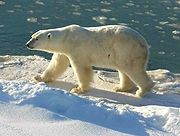 (Ours blanc or polaire) |
Ursus maritimus (Phipps Constantine Phipps, 2nd Baron Mulgrave Constantine John Phipps, 2nd Baron Mulgrave, PC was an English explorer and officer in the Royal Navy. He served during the Seven Years War and the American War of Independence, seeing action in a number of battles and engagements... , 1774) |
Edge of ice fields | Arctic Sea and coasts |
|
| Family Procyonidae Procyonidae Procyonidae is a New World family of the order Carnivora. It includes the raccoons, coatis, kinkajous, olingos, ringtails and cacomistles. Procyonids inhabit a wide range of environments, and are generally omnivorous.-Characteristics:... : Raccoons and allies |
||||
Common Raccoon_1.jpg) (Raton laveur) |
Procyon lotor (Linnaeus, 1758) |
Riparian forests | Southern Canada except Rockies and Cape Breton Island |
|
| Family Mustelidae Mustelidae Mustelidae , commonly referred to as the weasel family, are a family of carnivorous mammals. Mustelids are diverse and the largest family in the order Carnivora, at least partly because in the past it has been a catch-all category for many early or poorly differentiated taxa... : Mustelids |
||||
| Stoat Stoat The stoat , also known as the ermine or short-tailed weasel, is a species of Mustelid native to Eurasia and North America, distinguished from the least weasel by its larger size and longer tail with a prominent black tip...  (Hermine) |
Mustela erminea (Linnaeus, 1758) |
Varied | All of Canada except part of southern prairies and Anticosti Island |
|
| Long-tailed Weasel Long-tailed Weasel The long-tailed weasel , also known as the bridled weasel or big stoat is a species of mustelid distributed from southern Canada throughout all the United States and Mexico, southward through all of Central America and into northern South America.-Evolution:The long-tailed weasel is the product of... 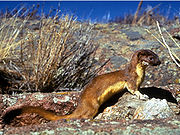 (Belette à longue queue) |
Mustela frenata (Lichtenstein Martin Lichtenstein Martin Hinrich Carl Lichtenstein was a German physician, explorer, zoologist, and herpetologist.-Biography:... , 1831) |
Open areas | Southern Rockies to western Ontario, southern Ontario to western Nova Scotia |
|
| Least Weasel Least Weasel The least weasel is the smallest member of the Mustelidae , native to Eurasia, North America and North Africa, though it has been introduced elsewhere. It is classed as Least Concern by the IUCN, due to its wide distribution and presumably large population... .jpg) (Belette pygmée) |
Mustela nivalis (Linnaeus, 1766) |
Varied | Yukon to Labrador, except southern Quebec and Ontario. |
|
| American Mink American Mink The American mink is a semi-aquatic species of Mustelid native to North America, though human intervention has expanded its range to many parts of Europe and South America. Because of this, it is classed as Least Concern by the IUCN. Since the extinction of the sea mink, the American mink is the...  (Vison d'Amérique) |
Mustela vison (Schreber, 177) |
Wetlands and rivers | Most of Canada, except the Arctic, part of the prairies and Anticosti Island. Introduced to Newfoundland |
|
| American Marten American Marten The American marten is a North American member of the family Mustelidae, sometimes referred to as the pine marten. The name "pine marten" is derived from the common but distinct Eurasian species of Martes... 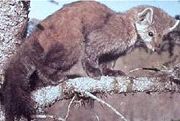 (Martre d'Amérique) |
Martes americana (Turton William Turton William Turton was a British naturalist.Turton was born at Olveston, Gloucestershire and was educated at Oriel College, Oxford. He commenced in practice at Swansea, but devoted his leisure time to natural history, especially conchology... , 1806) |
Coniferous and mixed forests | Rockies to Labrador and Newfoundland, except Prairies. Extinct in several parts of Eastern Canada. |
|
| Fisher Fisher (animal) The fisher is a medium-size mammal native to North America. It is a member of the mustelid family, commonly referred to as the weasel family. The fisher is closely related to but larger than the American Marten... .jpg) (Pékan) |
Martes pennanti (Erxleben, 1777) |
Coniferous and mixed forests near rivers | British Columbia to central Quebec, reintroduced in parts of the Maritimes. |
|
| Wolverine Wolverine The wolverine, pronounced , Gulo gulo , also referred to as glutton, carcajou, skunk bear, or quickhatch, is the largest land-dwelling species of the family Mustelidae . It is a stocky and muscular carnivore, more closely resembling a small bear than other mustelids...  (Carcajou) |
Gulo gulo (Linnaeus, 1758) |
Boreal forest, Arctic tundra | Largely extinct in southern Canada West of the Rockies. Found in much of continental Canada and the Arctic Islands |
Eastern Population
Western Population
|
| American Badger American Badger The American badger is a North American badger, somewhat similar in appearance to the European badger. It is found in the western and central United States, northern Mexico and central Canada, as well as in certain areas of southwestern British Columbia.Their habitat is typified by open...  (Blaireau d'Amérique) |
Taxidea taxus (Schreber, 1777) |
Fields | Southern Prairies, south-central British Columbia and southernmost Ontario |
|
| Northern River Otter Northern River Otter The North American river otter , also known as the northern river otter or the common otter, is a semiaquatic mammal endemic to the North American continent, found in and along its waterways and coasts. An adult river otter can weigh between 5 and 14 kg... 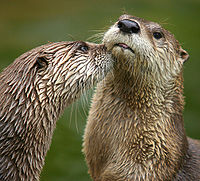 (Loutre de rivière) |
Lontra canadensis (Schreber, 1777) |
Rivers, lakes and swamps | Most of Canada except part of the Arctic and southern prairies |
|
| Sea Otter Sea Otter The sea otter is a marine mammal native to the coasts of the northern and eastern North Pacific Ocean. Adult sea otters typically weigh between 14 and 45 kg , making them the heaviest members of the weasel family, but among the smallest marine mammals... 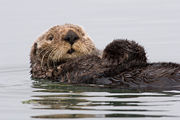 (Loutre de mer) |
Enhydra lutris (Linnaeus, 1758) |
Sea and coast | Vancouver Vancouver Island Vancouver Island is a large island in British Columbia, Canada. It is one of several North American locations named after George Vancouver, the British Royal Navy officer who explored the Pacific Northwest coast of North America between 1791 and 1794... and Goose Island Goose Island -Places in Australia:* Goose Island * Goose Island ** Little Goose Island ** Inner Little Goose Island* Goose Island , two islands-Places in Canada:*Goose Islands... coast |
|
| Family Mephitidae: Skunks | ||||
| Western Spotted Skunk Western Spotted Skunk The Western Spotted Skunk is a spotted skunk found throughout the western United States, northern Mexico, and southwestern British Columbia. With a total length of , the Western Spotted Skunk is smaller than the Striped Skunk . Their habitat is mixed woodlands, open areas, and farmlands. They... (Moufette tachetée occidentale) |
Spilogale gracilis (Merriam, 1890) |
Thickets and bushes | Southwestern British Columbia |
|
| Striped Skunk Striped Skunk The striped skunk, Mephitis mephitis, is an omnivorous mammal of the skunk family Mephitidae. Found over most of the North American continent north of Mexico, it is one of the best-known mammals in Canada and the United States.-Description:...  (Moufette rayée) |
Mephitis mephitis (Schreber, 1776) |
Forests, cultivated areas, valleys | Rockies to the Maritmes. Introduced in Prince Edward Island and Nova Scotia in the 19th century. |
|
| Superfamily Pinnipedia: Pinnipeds | ||||
| Family Otariidae: Eared seals | ||||
| Northern Fur Seal Northern Fur Seal The Northern fur seal is an eared seal found along the north Pacific Ocean, the Bering Sea and the Sea of Okhotsk. It is the largest member of the fur seal subfamily and the only species in the genus Callorhinus.-Physical description:Northern fur seals have extreme sexual dimorphism, with males... 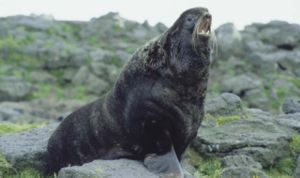 (Otarie à fourrure) |
Callorhinus ursinus (Linnaeus, 1758) |
Sea | Off the coast of British Columbia; appreciates rocky outcrops. Occasionally reported from the Arctic. |
|
Steller Sea Lion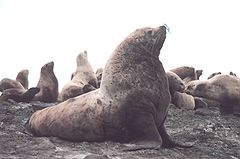 (Otarie de Steller) |
Eumetopias jubatus (Schreber, 1776) |
Coast waters | British Columbia; appreciates rocky outcrops. |
|
| California Sea Lion California Sea Lion The California sea lion is a coastal sea lion of western North America. Their numbers are abundant , and the population continues to expand about 5% annually. They are quite intelligent and can adapt to man-made environments...  (Otarie de Californie) |
Zalophus californianus ((Lesson René-Primevère Lesson René Primevère Lesson was a French surgeon, naturalist, ornithologist, and herpetologist.Lesson was born at Rochefort, and at the age of sixteen he entered the Naval Medical School there... , 1828)) |
Coast waters | Near Vancouver Island. |
|
| Walrus Walrus The walrus is a large flippered marine mammal with a discontinuous circumpolar distribution in the Arctic Ocean and sub-Arctic seas of the Northern Hemisphere. The walrus is the only living species in the Odobenidae family and Odobenus genus. It is subdivided into three subspecies: the Atlantic...  (Morse) |
Odobenus rosmarus (Linnaeus, 1758) |
Arctic shallows | James Bay to Groenland. Extinct in Western Arctic and the Magdalen Islands. |
|
| Family Phocidae: Earless seals | ||||
| Hooded Seal Hooded Seal The hooded seal is an arctic pinniped found only in the central and western North Atlantic ranging from Svalbard in the east to the Gulf of St... 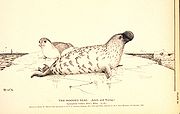 (Phoque à capuchon) |
Cystophora cristata (Erxleben, 1777) |
Sea | Atlantic from Gulf of the Saint Lawrence to northern Baffin Island. |
|
| Bearded Seal Bearded Seal The bearded seal , also called the square flipper seal, is a medium-sized pinniped that is found in and near to the Arctic Ocean. It gets its generic name from two Greek words that refer to its heavy jaw...  (Phoque barbu) |
Erignathus barbatus (Erxleben, 1777) |
Sea | Arctic Ocean |
|
| Grey Seal Grey Seal The grey seal is found on both shores of the North Atlantic Ocean. It is a large seal of the family Phocidae or "true seals". It is the only species classified in the genus Halichoerus... 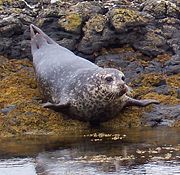 (Phoque gris) |
Halichoerus grypus (Erxleben, 1777) |
Sea rocks, and reefs | East Coast |
|
| Northern Elephant Seal Northern Elephant Seal The northern elephant seal is one of two species of elephant seal . It is a member of the family Phocidae . Elephant seals derive their name from their great size and from the male's large proboscis, which is used in making extraordinarily loud roaring noises, especially during the mating...  (Éléphant de mer du Nord) |
Mirounga angustirostris (Gill Theodore Gill Theodore Nicholas Gill was an American ichthyologist, mammalogist, malacologist and librarian.Born and educated in New York City under private tutors, Gill early showed interest in natural history. He was associated with J... , 1866) |
Tropical and temperate sea waters | Occasional in British Columbia |
|
| Harp Seal Harp Seal The harp seal or saddleback seal is a species of earless seal native to the northernmost Atlantic Ocean and adjacent parts of the Arctic Ocean. It now belongs to the monotypic genus Pagophilus. Its scientific name, Pagophilus groenlandicus, means "ice-lover from Greenland", and its synonym, Phoca... 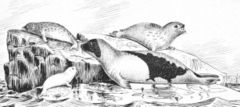 (Phoque du Groenland) |
Phoca groenlandica (Erxleben, 1777) |
Cold waters | Gulf of Saint Lawrence to James Bay and Groenland. |
|
Harbour Seal (Phoque commun) |
Phoca vitulina Linnaeus, 1758 |
Coast waters and some interior lakes. | Most Canadian coasts except the colder part of the Arctic |
|
| Ringed Seal Ringed Seal The ringed seal , also known as the jar seal and as netsik or nattiq by the Inuit, is an earless seal inhabiting the Arctic and sub-Arctic regions... 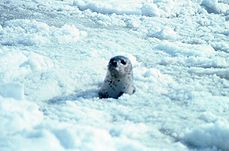 (Phoque annelé) |
Pusa hispida (Schreber, 1775) |
Arctic waters and ice-floes | Arctic Ocean |
|
Order Artiodactyla: Even-toed ungulates
The Even-toed ungulateEven-toed ungulate
The even-toed ungulates are ungulates whose weight is borne about equally by the third and fourth toes, rather than mostly or entirely by the third as in odd-toed ungulates such as horses....
s are ungulate
Ungulate
Ungulates are several groups of mammals, most of which use the tips of their toes, usually hoofed, to sustain their whole body weight while moving. They make up several orders of mammals, of which six to eight survive...
s whose weight is borne about equally by the third and fourth toes, rather than mostly or entirely by the third as in perissodactyls. There are about 220 artiodactyl species worldwide, including many that are of great economic importance.
| Common name (French French language French is a Romance language spoken as a first language in France, the Romandy region in Switzerland, Wallonia and Brussels in Belgium, Monaco, the regions of Quebec and Acadia in Canada, and by various communities elsewhere. Second-language speakers of French are distributed throughout many parts... name) |
Species (Authority) |
Preferred habitat | Native range | Status |
|---|---|---|---|---|
| Family Cervidae: Deers | ||||
| Wapiti Elk The Elk is the large deer, also called Cervus canadensis or wapiti, of North America and eastern Asia.Elk may also refer to:Other antlered mammals:...  (Elk) |
Cervus canadensis (Linnaeus, 1758) |
Varied, prefers open areas. | Southern Rockies and part of the prairies, reintroduced in several part of its former range. |
|
| Moose Moose The moose or Eurasian elk is the largest extant species in the deer family. Moose are distinguished by the palmate antlers of the males; other members of the family have antlers with a dendritic configuration... .jpg) (Orignal) |
Alces alces (Linnaeus, 1758) |
Subarctic and open forests | Yukon to New Brunswick. Introduced in Newfoundland, Cape Breton and Anticosti Islands. |
|
| Mule deer Mule Deer The mule deer is a deer indigenous to western North America. The Mule Deer gets its name from its large mule-like ears. There are believed to be several subspecies, including the black-tailed deer...  (Cerf mulet) |
Odocoileus hemionus (Rafinesque, 1817) |
Subarctic and open forests | West Coast to Prairies |
|
| White-tailed deer White-tailed Deer The white-tailed deer , also known as the Virginia deer or simply as the whitetail, is a medium-sized deer native to the United States , Canada, Mexico, Central America, and South America as far south as Peru... 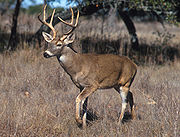 (Cerf de Virginie) |
Odocoileus virginianus (Zimmerman, 1780) |
Glens, rivers, marshes, forest edges. | Southern Rockies and Prairie Provinces to coast of Labrador and Maritimes. Introduced on Prince Edward and Anticosti Islands. |
|
Caribou (Caribou) |
Rangifer tarandus (Zimmerman, 1780) |
Tundra, Taiga and boreal forest | Boreal forests across Canada, art parts of the Arctic and Rockies |
|
| Family Antilocapridae: The Pronghorn | ||||
| Pronghorn Pronghorn The pronghorn is a species of artiodactyl mammal endemic to interior western and central North America. Though not an antelope, it is often known colloquially in North America as the prong buck, pronghorn antelope, or simply antelope, as it closely resembles the true antelopes of the Old World and...  (Antilope d'Amérique or Pronghorn) |
Antilocapra americana (Ord, 1815) |
Prairies and plains | Southern Saskatchewan and Alberta. |
|
| Family Bovidae: Bovids | ||||
| American Bison American Bison The American bison , also commonly known as the American buffalo, is a North American species of bison that once roamed the grasslands of North America in massive herds... 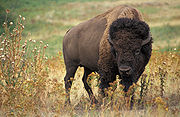 (Bison) |
Bison bison (Linnaeus, 1758) |
Varied | South of the Great Slaves Lake. Small reintroduced population found in several parts of its former range. |
|
| Mountain goat Mountain goat The Mountain Goat , also known as the Rocky Mountain Goat, is a large-hoofed mammal found only in North America. Despite its vernacular name, it is not a member of Capra, the genus of true goats... 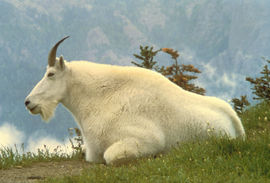 (Chèvre de montagne) |
Oreamnos americanus (Blainville Henri Marie Ducrotay de Blainville Henri Marie Ducrotay de Blainville was a French zoologist and anatomist.Blainville was born at Arques, near Dieppe. In about 1796 he went to Paris to study painting, but he ultimately devoted himself to natural history, and attracted the attention of Georges Cuvier, for whom he occasionally... , 1816) |
Mountains | Various parts of the Western Cordillera |
|
Muskox (Boeuf musqué) |
Ovibos moschatus (Zimmermann, 1780) |
Arctic tundra | Canadian Arctic |
|
| Bighorn Sheep Bighorn Sheep The bighorn sheep is a species of sheep in North America named for its large horns. These horns can weigh up to , while the sheep themselves weigh up to . Recent genetic testing indicates that there are three distinct subspecies of Ovis canadensis, one of which is endangered: Ovis canadensis sierrae...  (Mouflon d'Amérique) |
Ovis canadensis (Shaw, 1804) |
Alpine prairies | South and southeastern Rockies |
|
| Dall Sheep Dall Sheep The Dall sheep , Ovis dalli, is a species of sheep native to northwestern North America, ranging from white to slate brown in color and having curved yellowish brown horns... 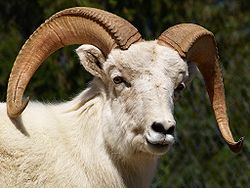 (Mouflon de Dall) |
Ovis dalli Nelson Edward William Nelson Edward William Nelson was an American naturalist and ethnologist. He was born in Manchester, New Hampshire. In 1871 together with his family, he became homeless due to the Chicago Fire.... , 1884 |
Alpine tundra | Yukon and northern British Columbia |
ssp. dalli
|
Order Didelphimorphia: Opossums
DidelphimorphiaDidelphimorphia
Opossums make up the largest order of marsupials in the Western Hemisphere, including 103 or more species in 19 genera. They are also commonly called possums, though that term technically refers to Australian fauna of the suborder Phalangeriformes. The Virginia opossum was the first animal to be...
is the order of common opossums of the Western Hemisphere
Western Hemisphere
The Western Hemisphere or western hemisphere is mainly used as a geographical term for the half of the Earth that lies west of the Prime Meridian and east of the Antimeridian , the other half being called the Eastern Hemisphere.In this sense, the western hemisphere consists of the western portions...
. Opossums probably diverged from the basic South America
South America
South America is a continent situated in the Western Hemisphere, mostly in the Southern Hemisphere, with a relatively small portion in the Northern Hemisphere. The continent is also considered a subcontinent of the Americas. It is bordered on the west by the Pacific Ocean and on the north and east...
n marsupial
Marsupial
Marsupials are an infraclass of mammals, characterized by giving birth to relatively undeveloped young. Close to 70% of the 334 extant species occur in Australia, New Guinea, and nearby islands, with the remaining 100 found in the Americas, primarily in South America, but with thirteen in Central...
s in the late Cretaceous
Cretaceous
The Cretaceous , derived from the Latin "creta" , usually abbreviated K for its German translation Kreide , is a geologic period and system from circa to million years ago. In the geologic timescale, the Cretaceous follows the Jurassic period and is followed by the Paleogene period of the...
or early Paleocene
Paleocene
The Paleocene or Palaeocene, the "early recent", is a geologic epoch that lasted from about . It is the first epoch of the Palaeogene Period in the modern Cenozoic Era...
.They are small to medium-sized marsupials, about the size of a large house cat
Cat
The cat , also known as the domestic cat or housecat to distinguish it from other felids and felines, is a small, usually furry, domesticated, carnivorous mammal that is valued by humans for its companionship and for its ability to hunt vermin and household pests...
, with a long snout and prehensile tail.
| Common name (French French language French is a Romance language spoken as a first language in France, the Romandy region in Switzerland, Wallonia and Brussels in Belgium, Monaco, the regions of Quebec and Acadia in Canada, and by various communities elsewhere. Second-language speakers of French are distributed throughout many parts... name) |
Species (Authority) |
Preferred habitat | Native range | Status |
|---|---|---|---|---|
| Family Didelphidae: New World opossums | ||||
| Virginia Opossum Virginia Opossum The Virginia opossum , commonly known as the North American opossum or tlacuache in Mexico, is the only marsupial found in North America north of Mexico. A solitary and nocturnal animal about the size of a domestic cat, and thus the largest opossum, it is a successful opportunist... 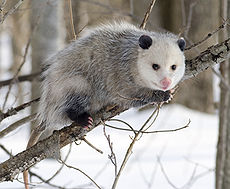 (Oppossum d'Amérique or de Virginie) |
Didelphis virginiana (Kerr, 1792) |
Humid lowland forests. | Southwestern Quebec, Ontario and British Columbia. Considered an exotic species by British Columbia. |
|
Introduced or accidental species
A number of wild mammalians may be found in Canadian territory without being confirmed natives. Some were voluntarily or involuntarily introduced. These include the House MouseHouse mouse
The house mouse is a small rodent, a mouse, one of the most numerous species of the genus Mus.As a wild animal the house mouse mainly lives associated with humans, causing damage to crops and stored food....
(Mus musculus), and Norway and Black Rat
Black Rat
The black rat is a common long-tailed rodent of the genus Rattus in the subfamily Murinae . The species originated in tropical Asia and spread through the Near East in Roman times before reaching Europe by the 1st century and spreading with Europeans across the world.-Taxonomy:The black rat was...
s (respectively Rattus norvegicus and R. rattus). Other include escaped animals; the Coypu
Coypu
The coypu , , also known as the river rat, and nutria, is a large, herbivorous, semiaquatic rodent and the only member of the family Myocastoridae. Originally native to subtropical and temperate South America, it has since been introduced to North America, Europe, Asia, and Africa, primarily by...
(Myocastor coypus), European Rabbit
European Rabbit
The European Rabbit or Common Rabbit is a species of rabbit native to south west Europe and north west Africa . It has been widely introduced elsewhere often with devastating effects on local biodiversity...
(Oryctolagus cuniculus) and Hares
European Hare
The European hare , also known as the brown hare, Eastern Jackrabbit and Eastern prairie hare, is a species of hare native to northern, central, and western Europe and western Asia. It is a mammal adapted to temperate open country. It is related to the similarly appearing rabbit, which is in the...
(Lepus europaeus), as well as feral cats, dogs and horses fall into this category. Fallow Deer
Fallow Deer
The Fallow Deer is a ruminant mammal belonging to the family Cervidae. This common species is native to western Eurasia, but has been introduced widely elsewhere. It often includes the rarer Persian Fallow Deer as a subspecies , while others treat it as an entirely different species The Fallow...
s (Dama dama) and Wild Boars (Sus scrofa) were introduced for hunting.
Finally, other species are encountered only accidentally, or so rarely in Canadian territory that it is impossible to tell whether they are permanent resident. Most of these species are cetaceans, some generally poorly known: Risso's Dolphin
Risso's Dolphin
Risso's dolphin is the only species of dolphin in the genus Grampus.-Taxonomy:Risso's dolphin is named after Antoine Risso, whose description formed the basis of the first public description of the animal, by Georges Cuvier, in 1812...
(Grampus griseus), the Dwarf
Dwarf Sperm Whale
The Dwarf Sperm Whale is one of three species in the sperm whale family. They are not often sighted at sea. As such, most information is a result of the study of stranded carcasses.-Taxonomy:...
and Pygmy Sperm Whale
Pygmy Sperm Whale
The Pygmy Sperm Whale is one of three species of toothed whale in the sperm whale family. They are not often sighted at sea, and most of what is known about them comes from the examination of stranded specimens.-Taxonomy:...
s (Kogia sima and K. breviceps), Blainville's
Blainville's Beaked Whale
Blainville's beaked whale , or the dense-beaked whale, is the widest ranging mesoplodont whale and perhaps the most documented. Henri de Blainville first described the species in 1817 from a small piece of jaw—the heaviest bone he had ever come across—which resulted in the name densirostris...
and True's Beaked Whale
True's Beaked Whale
The True's Beaked Whale is a medium sized whale in the Mesoplodont genus. The common name is in reference to Frederick W. True, a curator at the United States National Museum...
(Mesoplodon densirostris and M. mirus), the False Killer Whale
False Killer Whale
The False Killer Whale is a cetacean, and the third largest member of the oceanic dolphin family . It lives in temperate and tropical waters throughout the world. As its name implies, the False Killer Whale shares characteristics, such as appearance, with the more widely known Orca...
(Pseudorca crassidens), and the Striped Dolphin
Striped Dolphin
The Striped Dolphin is an extensively studied dolphin that is found in temperate and tropical waters of all the world's oceans.-Taxonomy:...
(Stenella coeruleoalba). The Big Free-tailed
Big Free-tailed Bat
The Big Free-tailed Bat is a bat species found in South, North and Central America. They have a wingspan of 435 mm and an average length of 140 mm. This bat frequents rocky or canyon country where it roosts in crevices. This migratory species is a swift, powerful flier, and occasional individuals...
and Evening Bat
Evening Bat
The Evening Bat is a species of bat in the vesper bat family, Vespertilionidae, that is native to North America. It is a small bat found throughout much of the midwestern and eastern United States as well as northeastern Mexico. In many areas they are very common, but may be declining in some...
s (respectively Nyctinomops macrotis and Nycticeius humeralis), as well as the New England Cottontail
New England Cottontail
The New England Cottontail is a species of cottontail rabbit represented by fragmented populations in areas of New England, specifically from southern Maine to southern New York...
(Sylvilagus transitionalis) are found mostly in areas south of the U.S.-Canada frontier, and occasionally in Canada.
The only Canadian, and also last known specimen of the Sea Mink
Sea Mink
The Sea Mink, Neovison macrodon, is an extinct North American member of the family Mustelidae. It is the only mustelid, and one of only two terrestrial mammal species in the order Carnivora, to become extinct in historic times . The body of the sea mink was significantly longer than that of the...
(Mustela macrodon) was captured on Campobello Island, in Nova Scotia
Nova Scotia
Nova Scotia is one of Canada's three Maritime provinces and is the most populous province in Atlantic Canada. The name of the province is Latin for "New Scotland," but "Nova Scotia" is the recognized, English-language name of the province. The provincial capital is Halifax. Nova Scotia is the...
in 1894. It is unknown whether the species was ever native to the country, but an unidentified animal reported in 1785 suggest it might have been more common in the Maritimes.
Extinct, extirpated or reintroduced species
Out of three species that have gone extinct in Canada in written history, two have since been reintroduced. It is not clear whether a fourth species, the aforementioned Sea MinkSea Mink
The Sea Mink, Neovison macrodon, is an extinct North American member of the family Mustelidae. It is the only mustelid, and one of only two terrestrial mammal species in the order Carnivora, to become extinct in historic times . The body of the sea mink was significantly longer than that of the...
, was ever a resident of Canada.
The Black-footed Ferret
Black-footed Ferret
The Black-footed Ferret , also known as the American polecat or Prairie Dog Hunter, is a species of Mustelid native to central North America. It is listed as endangered by the IUCN, because of its very small and restricted populations...
(Mustela nigripes) went extinct in Canada in 1937. Between the 1950s and 1981, it was suspected to be extinct until a wild population was discovered in 1981 in Wyoming
Wyoming
Wyoming is a state in the mountain region of the Western United States. The western two thirds of the state is covered mostly with the mountain ranges and rangelands in the foothills of the Eastern Rocky Mountains, while the eastern third of the state is high elevation prairie known as the High...
. The Swift Fox
Swift Fox
The swift fox is a small light orange-tan fox around the size of a domestic cat found in the western grasslands of North America, such as Colorado, New Mexico and Texas. It also lives in Manitoba, Saskatchewan and Alberta in Canada, where it was previously extirpated...
and Sea Otter
Sea Otter
The sea otter is a marine mammal native to the coasts of the northern and eastern North Pacific Ocean. Adult sea otters typically weigh between 14 and 45 kg , making them the heaviest members of the weasel family, but among the smallest marine mammals...
both went extinct in Canada in the 1930s, but were successfully reintroduced in the beginning of the 1970s.
Further reading
- The Illustrated Encyclopedia Of North American Mammals, MobileReference, Ebooks Corporation. (2008), ISBN 9781605012797
See also
- Fauna of CanadaFauna of CanadaThe fauna of Canada is considered to be diverse across Canada. Canada has multiple ecosystems, ranging from lush forests of British Columbia, to the prairies of Western Canada, to the tundra of the Northern Canada. With a large land mass, and small population density, the wildlands of Canada...
- Lists of mammals by region
- List of prehistoric mammals

